| 9
CARS, NOT CASH
Chabad looks for car donations


Chabad looks for car donations

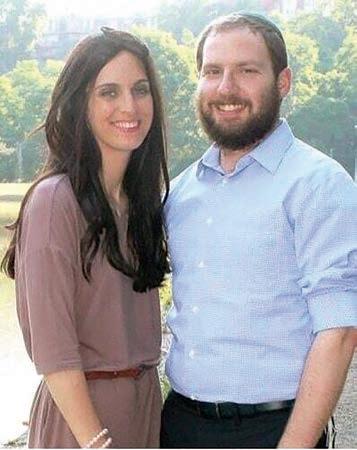 NICOLE RAZ | STAFF WRITER
NICOLE RAZ | STAFF WRITER
This year’s Martin Pear Jewish Community Center's fundraising gala brought together about 460 people in person after last year’s pandemic-induced pause.
It was Dan Noble’s first time out in a big crowd since last March.
“I just want to show support,” he said. “I’m not Jewish, but I have a lot of Jewish friends, and I’ve always enjoyed the events I’ve gone to (at the MPJCC).”
Noble, a doctor who has been involved in Arizona’s COVID response, said he has great concerns about the pandemic but felt relatively safe. He got his booster shot a week before the gala.

Aaron Vakneen also attended the gala. He’s been to several other large gatherings over the past two years and said it is important to come together now more than ever.
“You see the smiles, the laughter, the hugs and kisses — you’ve missed a lot of that these last two years. I think these galas and the events coming back, even though we’re taking the appropriate precautions, we’re able to come together as a community” he said. “It’s remarkably important to come out of this and be stronger than ever.”
The Dec. 4 event, which took place at the Arizona Biltmore, honored two community members, enjoyed a steady hum of schmoozing, featured an auction and moved a chunk of the crowd to sing and dance along to tunes by corporate entertainer Michael Cavanaugh.


Those facing illness aren’t alone
Kim Klett has taught about the Holocaust for 20 years. When her Holocaust Literature class debuted at Dobson High school in 2001, it was only the second of its kind offered in a public Arizona high school.
Having a whole class dedicated to Holocaust education has been “a real luxury,” she said. And for the last three years, it’s been a year-long class rather than the original semester course.

“It sounds crazy because I have a year, but the hardest part is I still have to limit myself in what I can do,” she said. “Trying to choose the best of what I think is out there — that’s been the most difficult for me.”
With Arizona recently mandating Holocaust education, many teachers around the state are now making some of those same tough decisions: How much time should be spent on the subject? What material should be featured? How does the subject get the attention it deserves with limited time
In 2020, the Arizona State Board of Education made a rule change requiring students to receive instruction on the Holocaust at least twice during their secondary schooling. Then in July, Gov. Doug Ducey signed legislation mandating that Arizona’s public schools teach about the Holocaust and
Temple Emanuel of Tempe’s men’s club lit the menorah atop Tempe Butte or “A Mountain” for Chanukah. To see more community photos, go to p. 22.

SEE GALA, PAGE 2
Neal Kurn was the second recipient of the William S. Levine Family Community Excellence Award, named after local philanthropist Bill Levine, who donated the funds to open the Ina Levine Jewish Community Campus. Kurn was honored for his many contributions to the Jewish community during his time leading and/or guiding the Jewish Federation of Greater
their wealth in our J. The foundation that you have built has given my family a home,” she said. “I plan to continue that path that you all have laid by investing my time and my wealth.”
Following the gala’s sit-down meal, a live auction featured prizes such as a dinner for 10 at Tarbell’s in Phoenix; a package of tickets for the Coyotes, Suns, Diamondbacks and Cardinals; a lifetime membership at the MPJCC; and a Napa Valley
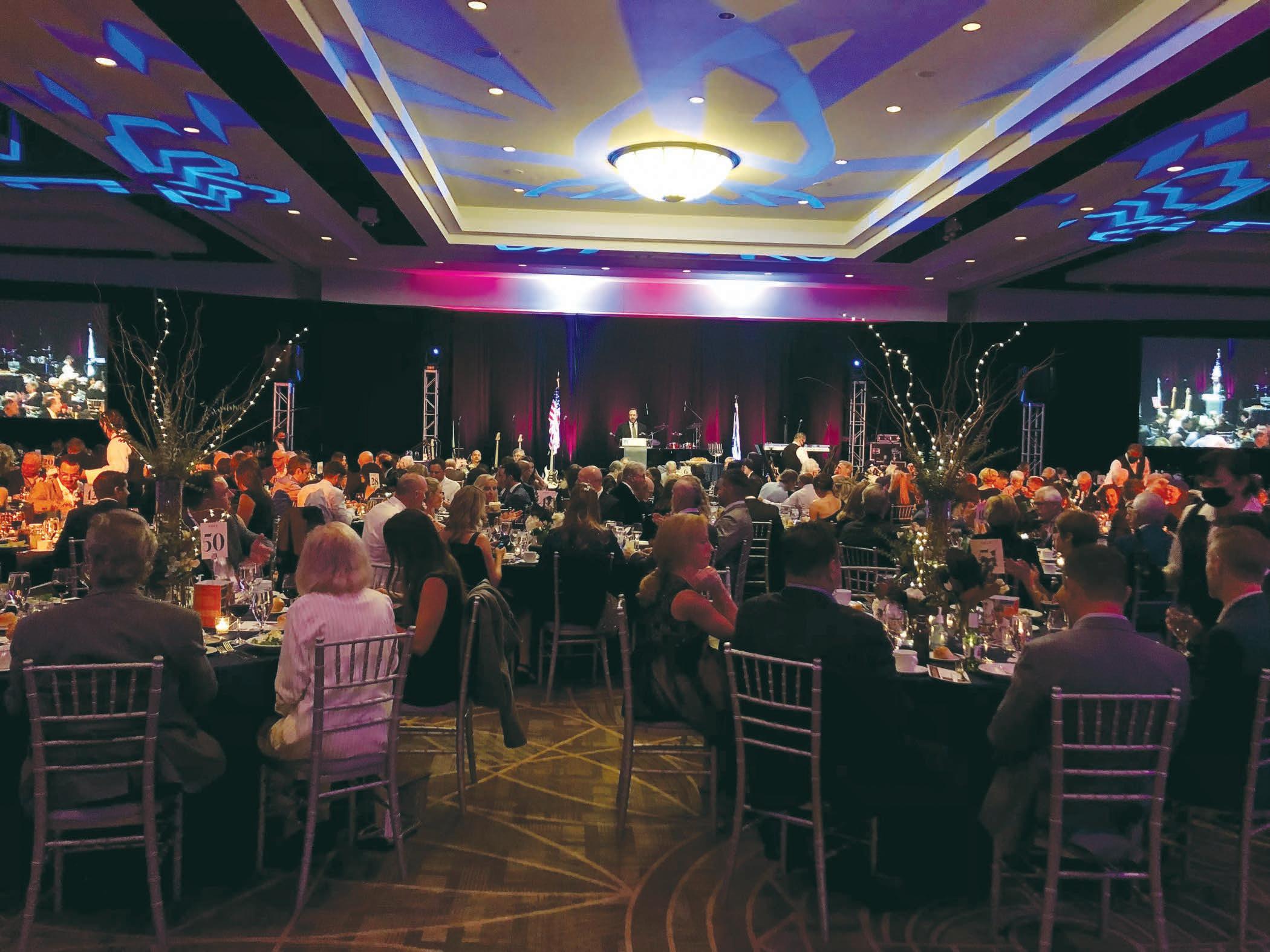
of the organization,” Jacobs said. “COVID restrictions impacted our membership and ability to provide the day-to-day services that cover operational expenses. We are working diligently on bringing back the traditional, as well as new, programs that members seek and benefit from each and every day.”
The MPJCC was able to transform its operations, quickly adapting to the pandemic’s changing needs. Jacobs said the organization
member experience, we are maintaining the swim lane reservation process coming out of the pandemic,” Jacobs said.
Everybody who attended the gala had to show proof of vaccination or negative PCR test results before entering.
Last year, the MPJCC ran a direct mail campaign rather than an in-person event and raised over $450,000. The amount raised at this year's event has not yet been released. JN
PUBLISHER Jewish Community Foundation of Greater Phoenix

GENERAL MANAGER Rich Solomon | 602.639.5861 rsolomon@jewishaz.com
MANAGING EDITOR Shannon Levitt | 602.639.5855 slevitt@jewishaz.com
STAFF WRITER Nicole Raz | 602.872.9470 nraz@jewishaz.com
ADVERTISING SALES CONSULTANT Jodi Lipson | 602.639.5866 jlipson@jewishaz.com


SUBSCRIPTIONS 602.870.9470 x 1 subscriptions@jewishaz.com
GRAPHIC DESIGNER Frank Wagner | 410.902.2300 ads_phoenixjn@midatlanticmedia.com
Friday 3 days prior to publication
Jaime Roberts, Publisher | 2013-2016
Florence Newmark Eckstein, Publisher | 1981-2013
Cecil Newmark, Publisher | 1961-1981
Pearl Newmark, Editor | 1961-1981
M.B. Goldman, Jr., Founder | 1948-1961
PROUD MEMBER OF

grades. The law went into effect Sept. 30.
Arizona is a local control state, meaning it is up to each school district, and in many cases, each teacher, to decide how to meet the requirements of the mandate and legislation, which also do not provide any guidance. There is no statewide requirement for how much instructional time must be spent on Holocaust education.
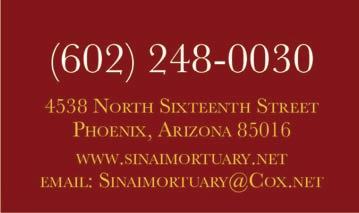
Klett said it would be helpful if the mandate or legislation were “more defined,” particularly with what aspects should be covered in junior high and what aspects should be covered in high school, so there could be a “clear progression.”
The Arizona Department of Education (ADE), working with the The Taskforce For Holocaust Education and Other Genocides — led by the Phoenix Holocaust Association — is doing its best to fill in any gaps by providing resources and professional development for teachers. Klett is also a PHA board member.
“We’re trying to help make things as easy for teachers as possible,” said Sheryl Bronkesh, PHA's president.
Bronkesh and Klett — who is also a senior facilitator with Echoes & Reflections, a nonprofit that provides professional development to educators to teach about the Holocaust — are both providing seminars, presentations and trainings to teachers on Holocaust education.
“What I’m hearing from a lot of teachers is that they feel very daunted,” Klett said. “They think that it’s a serious topic — and it is — and they want to give it the reverence and attention, and they want to make sure they do it well.”
The task force developed a toolkit for teachers looking for training on the subject matter and how to teach it, which ADE features on its website.
“That’s huge,” Bronkesh said. “I am so proud that we were able to involve professors from all three state universities, and from different community colleges, to survivors and other educators who worked together quickly to develop that resource. To me, that’s a major achievement.”
The toolkit presents as a web page with a short introduction and a menu of options that include a “Getting Started Guide from the U.S. Holocaust Memorial Museum,” which includes lesson plans and other resources; classroom lessons and videos; tips, resources and training materials for teachers on the Holocaust and other genocides; and recorded webinars and presentations.
Terri Welsh, secondary social studies specialist with the Mesa Public School District, said she gets regular notifications from the PHA about new educational tools and materials that are available. “I do send those out to teachers, and let them know in department chair meetings,” she said. But, she said, it can be overwhelming to sort through all that is available, especially for teachers. “We try to pick out the best. Since this legislation is pretty new, teachers are grappling with what is the best stuff to
bring into the classroom, and it’s going to be a process.”
Teachers across the district have long been teaching about the Holocaust and other genocides, Welsh said. However, the recent rule changes and legislation have made the district and teachers even more conscious of Holocaust education, she said.
The district recently began offering teachers a monthly series of 90-minute workshops with Echoes & Reflections, a program of the USC Shoah Foundation, Yad Vashem and the Anti-Defamation League.
“At the district level, we’re just making sure that teachers are aware of the legislation and are making sure that they are taking time and space to teach about it and to teach it well,” Welsh said.
A spokeswoman for the Peoria School Unified School District said it has greatly expanded its Holocaust instruction since last October to include exploration of prewar Jewish life, connections between the Holocaust and contemporary antisemitism, Jewish resistance during the Holocaust, exploring the inactions of individuals and groups as it relates to bystanders, collaborators and perpetrators and more.
Erin Dunsey, communications manager for the Peoria Unified School District, said as teachers become more confident in teaching the Holocaust and other genocides, “we hope to see some great things happening in classrooms as students explore this difficult time in history.”
She noted the district is using the resources provided on the ADE website.
Nancy Norman, a spokeswoman for the Scottsdale Unified School District, said the 2020 rule change and following legislation has had little impact on the district. Following the 2018 revision to Arizona Social Science standards, which addressed Holocaust education at the middle and high school level, teachers throughout the district worked together in the Fall of 2019 to develop a curriculum that addressed Holocaust education.
“This important education was first taught to SUSD students last year, in the 2020-2021 school year,” she said.
The 2018 History and Social Science Standards required coverage of the Holocaust and other genocides in eighth grade and again in high school, but Morgan Dick, a spokeswoman for ADE, said the recent legislation “put a spotlight on how critical it is to teach this content to students and also emphasized this to administrators, teachers and parents.”

Margaret Fountain, social studies content specialist with the Tempe Union High School District, said the district also was minimally impacted because of its work following the 2018 Social Studies Standards revision. “We found that we had included a comprehensive study of the Holocaust,” she said. But she has curated more materials for teachers on the topic, including from the toolkit featured on the ADE website, and shared them with teachers.
She has also attended training with the ADE on Holocaust instruction and has
shared that as well as other professional development opportunities. “For example, I recently received information that the East Valley Jewish Community Center has offered us the opportunity to do a virtual tour with our students of Auschwitz and I sent this out to my teachers,” she said.
Becky Kelbaugh, a spokeswoman with the Paradise Valley Unified School District, said it is also using the resources available on the ADE site, and said the mandate and legislation has minimally impacted the district. “Holocaust education has been part of K-12 education for several years and is embedded within the district’s curriculum,” she said. “Since the legislation, more resources regarding the Holocaust have been provided to teachers to supplement what they had already been teaching.”

A spokesman for the Chandler Unified School District said staff is in the process of reviewing their plan and was not able to provide further details.
Spokespeople for the Phoenix Union High School, Glendale Union High School, Cave Creek Unified School and Flagstaff Unified districts did not return a request for comment.
A national survey found last September that “when asked how many Jews were killed during the Holocaust, 63% of Millennials (those aged 25-40) and Gen Z (those aged 18-24) did not know 6 million Jews were murdered.” That figure climbed to 67% in Arizona. The survey, commissioned by the Conference on Jewish Material Claims Against Germany, also found 11% of national respondents — 15% in Arizona — believe Jews caused the Holocaust.
Klett, who graduated from an Iowa high school in 1985, said she never learned about the Holocaust until she took a Holocaust Literature class at Arizona State University. She began teaching at Dobson High School in 1991, and in the late '90s she explored the idea of getting a doctoral degree in English. She took a variety of classes to see what she wanted to do.
The Holocaust literature class “was just such an eye opener,” she said. She was always interested in social issues and injustice, and once she learned about the Holocaust she couldn’t stop reading about it. “I was really just intrigued by the topic,” and she knew her high school students would connect with the topic and its messages.
When students learn about the Holocaust, they tend to think, “Oh, that’s so sad,” and “Good thing that’s over,” Klett said. But, of course, that is not the case as genocides are still happening. “I think it is super important to empower our students to become activists against genocide, and against hatred and bigotry and antisemitism and all those other ‘isms,’ and just making them aware of that and the power that they do have moving forward.”
In addition to teaching and being a senior facilitator with Echoes & Reflections, Klett is also a museum teacher fellow with the United States Holocaust Memorial Museum, and the deputy executive director of the Educator’s Institute for Human Rights. JN

When the family travels home for a winter visit, Steve is thrown together with all his dysfunctional kin in a riotous seasonal celebration. We attend a family dinner at Grandma’s where, if you’re under 55 you still sit at the children’s table, and 35 over-fed people share one toilet! From the creator of My Mother’s Italian My Father’s Jewish & I’m In Therapy, we bring you a new show for the winter season.
Mt. Sinai Cemetery in Phoenix is expanding.

The last time this happened was just four or five years ago, Ira Mann, Mt. Sinai’s general manager, estimates. The cemetery added about 500 plots then, and Mann didn’t expect to be needing another expansion so quickly.
- WCBS TV
Box Office: 602-252-8497

Groups (12+): 1-888-264-1788 HerbergerTheater.org or PlayhouseInfo.com
222 E. Monroe, Phoenix, AZ 85004
Due to the growth of Greater Phoenix’s Jewish community, people with preplanned arrangements who are passing away and the COVID-19 pandemic, burials have been up 50% compared to pre-COVID times. More families are also making provisions ahead of time. A 2021 survey by the National Funeral Directors Association found the pandemic motivated 37.8% of respondents to pre-plan their own funeral and/or memorial arrangements.
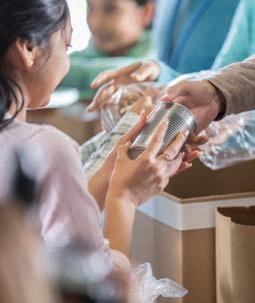

“This time, we expanded even more,” Mann said, noting 1,800 plots opened Monday, Dec. 6. “It’s been a wild ride these past couple of years.”
The cemetery opened in 2005 and sits on 32 acres, eight of which are developed. The Jewish community has grown exponentially in the years since. A 2019 Arizona State University report found the Jewish population in Maricopa County has grown by 19% since 2002.
“Our goal is to accommodate every single Jewish person in the Jewish community down here,” Mann said.
He said the vast majority of the staff’s work — 90% — is working with families on pre-planning arrangements.

“It’s not just people coming here and buying because somebody passed of COVID. They’re coming here because they don’t want their family to take care of it, to pass this burden onto their kids,” Mann said. “The worst time to make financial decisions is when someone has passed.”
The process is straightforward. An individual or a couple chooses which plot they would like — Mann calls this part choosing “their last condo” — a headstone, and whether they would like multiple sites. Some even choose the color of their monuments or design one themselves. The cemetery also recently started offering full ledger grave markers, something that completely covers the grave.
“We’re getting a lot of heritage in here,” he said. “Not only are the parents buying it, but the kids are buying plots so they can keep the family together.”
Mann plans to spend his afterlife at Mt. Sinai with his aunt, uncle and cousins. He has two plots.
The pandemic has created some challenges for the cemetery, but it has never
had a problem offering burials within 24 hours of somebody’s passing.
“We were able to accommodate every single one that walks through the door, and we’ve become very close to a lot of the families,” he said. “It’s been a busy, busy, busy year and I am a little tired, but we made it through the rain.”
Mann has seen a fair amount of unexpected deaths over the past two years, and it’s been difficult every time.
“You kind of have to figure out your own way how to be at peace with yourself with everything that goes on,” he said. “I truly feel there’s an order, and I don’t believe a parent should ever be burying a kid. And it’s been very, very hard. There’s definitely been a lot more than normal the past couple of years.”
While other cemeteries in Greater Phoenix are attached to a synagogue or have explicitly Jewish sections, Mt. Sinai Cemetery is exclusively Jewish, with sections named after biblical matriarchs and patriarchs.
Mann said the owners traded 27% of burial space to ensure there would be a sidewalk in front of every grave.
“This way, no one is walking on anyone’s grave. I don’t have anyone driving over anyone’s grave. I don’t have any lawn mowers going over people’s graves because we’re a desert landscape cemetery,” he said.
This latest expansion should last quite a few years, Mann said. When it’s time for the next one, there will be plenty more space available.
“We have room for the next 100 years or so: For me, my successor, and his successor,” he said. JN
“Hysterically Funny! Non-Stop Laughs All The Way!”
- Regis Philbin, Live With Regis & Kelly
Peter Fogel
“As Heartwarming As Comfort Food. Everyone Can Relate to This!”
- Martha Stewart Living Radio
“A Funny Look At Family Relationships! An Entire Family Wrapped Up In A One-Man Show!”
As 2022 approaches, Arizona State University’s Jewish organizations are examining their goals for the coming year to better serve Jewish students.
The three best-known Jewish organizations, Olami at ASU, Hillel at ASU and Chabad at ASU, have individual missions, but most students move among them easily. Ahead of the next semester, all are thinking about how to reach more of the Jewish student body.
Nathan Chmelnik, a graduate student studying industrial engineering, has some ideas.
“[Olami, Hillel and Chabad] should focus on instilling Jewish identity in students,” he said. Many students “know they’re Jewish, but they don’t feel it… I feel these events do a great job in helping us feel excited about being Jewish, proud to be Jewish and continuing to be an active part of this community.”
He said, “all it takes is one event where they have fun” to make Jewish students feel comfortable in the Jewish community on campus.
“Once they’re here, they stay,” Chmelnik said. “The hardest part is just getting them in the door.”
Fun events and more are in the organizations’ plans.
Next semester, Olami plans to continue “connecting Jewish students to their heritage and to each other,” said Risa Brumer, Olami Arizona’s director.

“This semester we started up our JBiz and JHealth chapters,” she said “We have just added JTech, as well. Next semester, we plan to expand them both in terms of membership and in terms of programming.”
JBiz, JHealth and JTech are clubs for Jewish students looking to enter the business, health and technology fields, respectively. The programs offer mentorship from industry leaders, retreats for members and help with applying for jobs and internships.
“There are thousands of Jews on campus,” Brumer said. “We just need to make sure they know where they can find us.”
Hillel at ASU will be hosting more events and programs as well as helping students “explore Jewish spaces and identity,” said Taylor Millman, the organization’s assistant director.
“The pandemic has taught us how to be flexible, gather feedback quickly and be readily available to meet students’ needs,” Millman said. Plans for social events like the Fall Food Truck Fest are in the works. She said Birthright and other “immersive experiences,” too, will be “up and running” soon.
The food truck event, hosted earlier this fall, attracted more than 100 people.
Millman wants to “ensure students have the chance to form a deeper connection

to their Jewish roots and peers,” she said. “We are very conscious of our calendar and work hard each semester to create a diverse set of programs and opportunities that cater to every type of student.”
Because having the confidence and peace of mind of accreditation is important. That’s why Maravilla Scottsdale’s assisted living and memory care services are accredited by CARF International—an independent, non-profit organization that sets exceedingly high standards for care, service and safeguards. It’s a lot like an accreditation for a hospital or college. Or a five-star rating for a hotel.
We think you’ll find that our accreditation is only one of the many reasons to take a good look at Maravilla Scottsdale.
Hundreds of Jews across Greater Phoenix celebrated Chanukah this year by attending a public menorah lighting and/or celebration.
Ora Kurland, who has organized a Chanukah celebration with Karen Acker in Carefree for the past five years, said the celebration is a chance for local Jews to come together and realize they are part of something bigger.
“The motto of the Jewish social group is, ‘I thought I was the only Jewish person in Cave Creek,’” Kurland joked.
The group offered programming for each night of Chanukah at the Sanderson Lincoln Pavilion in Carefree, which included guest speakers, music, food and raffles. A few hundred people, from young professionals to seniors, enjoyed the celebrations.
Chanukah ran from Nov. 28 to Dec.5, and public celebrations across the state went off without a hitch. Event organizers were pleased with both the turnout of the Jewish community and the support from non-Jews.
Chabad of Arizona Rabbi Dov Levertov organized the Chanukah on the Lawn event at the Biltmore Fashion Park in Phoenix, among other celebrations. The festivities included food, entertainment, speakers and activities for children.
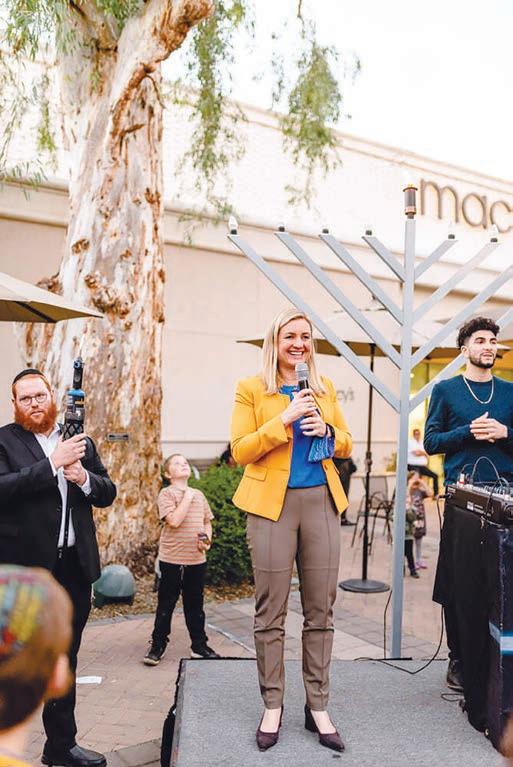
“Chanukah is the only Jewish holiday that we take to the streets,” he said. “It’s really the message of bringing light into the world and how one small drop of light can illuminate a much greater area full of darkness.”
The first night drew more than 500 people to Phoenix, and throughout Greater Phoenix more than 2,000 people attended a Chabad menorah lighting Nov. 28.
Chabad of the East Valley Rabbi Mendy Deitsch hosted several menorah lighting events, including a “Huge Chanukah extravaganza” at the Pollack Chabad Center in Chandler. He said more than 400 people came.
Chabad Jewish Center of Gilbert Rabbi Shimi Ash hosted lightings at SanTan Village in Gilbert, in Queen Creek and in San Tan Valley.
“Jews are very happy to engage with their Judaism in a public way,” he said.
Around 300 people came to the SanTan Village event, he said. Menorah lightings publicize the miracles of Chanukah and draw the biggest crowds of the year.
Chabad Lubavitch of Fountain Hills Rabbi Mendy
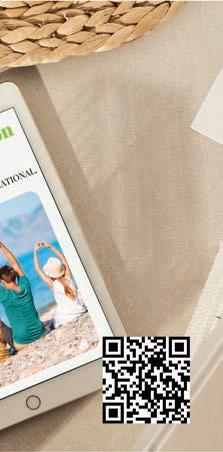


Lipskier hosted the 11th annual public menorah lighting and Chanukah celebration on Nov. 28, which also featured live music and food.
“People relate differently to any given Jewish holiday or practice, but one Jewish holiday that virtually every Jew relates to and has a warm feeling for is the holiday of Chanukah,” he said. “We try to make the menorah and holiday celebration as accessible as possible.”
About 200 people came, which is “a slight uptick” over previous years. He’s not sure whether that’s because of a growing Jewish community, or pent-up desire to be part of community celebrations due to the pandemic.
Celebrating Chanukah publicly is not only important for the miraculous nature of the holiday, but also to instill pride, especially for young Jews, and to remind the Jewish people they are tasked with “being a light unto the nations,” he said.
“Lighting the menorah in public and celebrating in public is an amazing opportunity that we shouldn’t squander,” he said.
The holiday came after months of news reports of rising antisemitism and surveys showing an increasing number of Jews feel threatened enough to hide their identity.
The FBI recorded the largest number of hate crimes last year since 2008, and the Jewish community was once again a top target of religiously motivated crimes.
Of the 1,174 religiously motivated hate crimes reported nationally to the FBI in 2020, anti-Jewish hate crimes accounted for 57%. The majority of incidents targeted individuals directly, 53% involved vandalism or property destruction, 33% involved intimidation and 10% entailed either simple or aggravated assault.
The FBI recorded 19 anti-Jewish hate crimes in Arizona.

A recent survey by the Pew Research Center found more than 9 in 10 Jews say there is at least “some” antisemitism in the United States, including 45% who say there is “a lot.” Slightly more than half of Jews surveyed (53%) nationally say that they feel less safe today than they did five years ago as a Jewish person in the U.S.
Kurland and Acker said there has never been any antisemtic incident during the public Chanukah events they’ve organized, but they hire security just in case.
Harold and Jean Grossman Chair in Jewish Studies
This three-part series will explore the role of rabbis in Jewish history from late antiquity until the dawn of the modern age; carve out definitions of rabbis and rabbinic culture; and assess the cultural contributions of individual rabbis through the ages.
all sessions free and open to all 7 p.m. | via Zoom and in person at the Martin Pear JCC 12701 N. Scottsdale Road, Scottsdale | room 218-219 limited seating capacity + masks will be required pre-registration required for each session
Jan. 13 | series
jewishstudies.asu.edu/talmudrabbis
The birth of rabbinic culture played a central role in reshaping Judaism in the immediate post-Temple era in the Galilee and Iraq, especially on shaping the Talmud and delineating spheres of communal authority. Explore the roles of major figures including R. Yochanan ben Zakkai, R. Akiva, Yehudah ha-Nasi, Abba Arikha, and Shmuel of Nehardea.
Jan. 20 | series
jewishstudies.asu.edu/middleagesrabbis
Explore the solidification of Diasporic rabbinic authority in medieval Baghdad, Spain, Tunisia, and Germany, focusing on the modes, methods, and langue of rabbinic discourse and communication. Learn about major figures such as Sa‘adia Gaon, Rabbenu Gershom, Nisim ben Jacob, Maimonides, and Samuel ibn Adret.
Jan. 27 | series
Rabbis of Early Modernity
jewishstudies.asu.edu/rabbismodernity
Explore the crisis of Rabbinic authority at the dawn of modernity in Italy, Western Europe, and the Ottoman Empire, focusing on the challenges to rabbinic authority from new forms of mysticism, messianism, and rationalism. Learn about the roles of figures like Samuel de Medina, Leone Modena, Menasseh ben Israel, Ya‘akov Emden, and Hayim Yosef David Azulai.
2022 Albert and Liese Eckstein Scholar-in-Residence

Pamela Nadell | American University
Jan. 24 | community lecture

7 p.m. | Zoom | free and open to all pre-registration required jewishstudies.asu.edu/eckstein
Women are no longer imprisoned by man-made myths. We are coming down from our pedestal and up from the laundry room.” When Bella Abzug wrote these words in 1972, she was just one of 14 women in the United States Congress. The other 521 were men. In the feminist movement of her day, Abzug stood among a striking cohort of Jewish leaders. This lecture looks back at some of these feminist icons and analyzes why Jewish women played outsized roles in this revolutionary movement.
Pamela Nadell is the author of America’s Jewish Women: A History from Colonial Times to Today, winner of the 2019 National Jewish Book Award–Jewish Book of the Year. A professor and Patrick Clendenen Chair in Women’s and Gender History at American University in Washington, DC, she is a recipient of the university’s highest faculty award, Scholar/ Teacher of the Year. As past president of the Association for Jewish Studies, she has also received the American Jewish Historical Society’s Lee Max Friedman Award for distinguished service to the profession. Currently, she is working on a book about the history of American antisemitism.

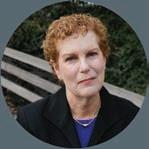
This annual program is made possible by an endowment established by the late Dr. Albert and Mrs. Liese Eckstein, with additional contributions from Paul and Flo Eckstein; John and Diane Eckstein; and Friends of Jewish Studies.
free pre-registration required jewishstudies.asu.edu/eckstein
Diamond Sponsors
$200,000+
Lodestar Foundation
Anonymous
Titanium Sponsor
$50,000
Anonymous
Gold Sponsors
$25,000
Anonymous
Arizona Community Foundation
Lee and Mike Cohn
Dottie and Murray Goodman
Suzanne and Steve Hilton
Rachel and Jonathan Hoffer
Sue and Neal Kurn
Millard and Beverly Seldin
Family Foundation
Scott Seldin, Trustee
Sue & Bud Selig
Silver Sponsors
$10,000
ABLE Financial Group
Anonymous
Cohn Family
Diana and Mark Feldman
Judy and Sam Linhart
Fennemore Craig, PC
Gerald Rosenbluth Family Fund, held at the Arizona Community Foundation
Donna and Joel Kramer MGKS
Northern Trust
“Weezie” and David Reese
Jenny and Daniel Shorr
SMS Financial
The Penny and Robert Sarver Charitable Foundation
The Yalowitz Zeidler Group of BAIRD Wealth Management
Weiss Wealth Strategies of Raymond James
Adiba and Marc Wichansky
Bronze Sponsors
$5,000
Anonymous
Alliance Bank of Arizona
Lori and Drew Brown
Denise and Robert Delgado
Flader & Young Consulting Group of RBC Wealth Management
Annette and Leonard Frankel
Friedman Recycling
Cindy and Stephen Good
Hensley Beverage Company
Jaburg Wilk
Michelle and Bryan Kort
Jennifer, Scot, Jacob, Jonah and Emma Endsley, Sharon, Joel and Kaela Marcus-Kurn, and Lynn and Jeff Kurn
MidFirst Bank
Nancy and Robert Kravetz
Lane & Nach, P.C. and R.O.I. Properties
Shirley and Bernard Levine
Valerie and Herschel Richter
RIESTER
Laurie and Gary Ringel
Sheila Schwartz
Silverware
Esther and Don Schon
Mort Scult
The Harold* and Jean* Grossman
Family Foundation
ViaWest Group
Village Medical
Laura and Wayne Yaffee
In-kind Sponsors to the Gala Auction and Raffle

APS
Arizona Cardinals
Arizona Diamondbacks
Capital Grille - Scottsdale
Mallory and Aaron Lebovitz
Mark Tarbell - Tarbell’s Restaurant
MidFirst Bank
Phoenix Coyotes
Phoenix Suns
Suzanne and Steve Hilton
The House of Diamonds
Brent and Mamello Taubman
*Of blessed memory

Fredric M. London has a two-car garage and carport at his Gilbert house. All of those spots are reserved for Brass Era cars and other classics that catch his eye.
“My interest in cars and everything else I collect is based on history,” he said. “Looks are nice, but that’s not my driving passion.”
He’s got a Horseless Carriage, a 1913 Model T, an 1898 Gasmobile and, until about a year ago, he had a 1953 Buick Super, too.
Despite its clean engine, it was covered in rust. London bought the Buick in 2008 with plans to restore it. “But I couldn’t get anybody to do it; nobody was interested,” he said. London asked Chabad of the East Valley Rabbi Mendy Deitsch if he could use it. That’s when he learned about Chabad’s Jewish Car Donation program.
“That was the place I wanted to donate. There’s no question of this or that — it was Chabad,” London said. “Chabad is a very worthy organization. They care about all Jews, they are good at teaching Judaism and I just really like them as an organization.”
London is among about a dozen locals who have donated cars to Chabad within the past year or so. Chabad also accepts RVs, boats, trucks, vans and trailers.
“We want to help the people that need it,” said Rabbi Zalman Levertov, head of Chabad of Arizona. If a donated car runs safely, it will go to a family, staff or volunteer in need. Otherwise, the cars are sold whole or for parts with proceeds supporting general operation costs.

People donate cars for a few reasons: it’s worth more as a charitable donation, it’s being replaced or just for the love of Chabad.
London received a tax benefit for donating the car — a few hundred dollars — but it was more of a nice bonus than a motivating factor.
“I thought it would be kind of nice to have the tax deduction, but I figured I can’t make anything out of it. Let me give it to an organization.”
Deitsch said he ended up selling it to a company that restores old cars. “They were happy to buy it from us, and we were able to put the funds to good use,” he said.
Not everybody who donates is eligible for a tax credit, though.
The Tax Cuts and Jobs Act of 2017 raised the threshold at which itemizing deductions results in a greater benefit than the standard deduction.
Seth Rosenberg, CEO of Ability First Financial, a tax planning and mitigation financial planning practice, said tax incentives aren’t top of mind for most altruistic donors anyway.
“The reality is that most donations are driven by a civic, social and religious responsibility long before the tax implications,” he said.
Michael Freeman, who lives in central
Phoenix, didn’t even consider the tax implications when he donated his Hyundai Tucson earlier this year to Chabad-Lubavitch of Arizona.
“So many of the Chabad rabbis have made a tremendous positive influence in my life, my family’s lives and lots of other people,” he said. “So I try to help as much as I can. I cannot give a million dollars, but I could certainly give a car that I am no longer going to be using that I think they can put to good use.”
Freeman has four kids and it was time to retire the SUV that had served him and his family for the past handful of years. It was drivable but needed repairs costing more than the car was worth, he said.
Rabbi Dov Levertov, co-director of Chabad of Arizona’s Aleph Bet Preschool and Kindergarten, said he ended up selling the car to a person who could fix it up himself and use it.
Freeman said he knew that Chabad of Arizona accepts donated cars, because he remembered seeing it a few times in a weekly newsletter.
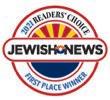
Dov Levertov said the program doesn’t have heavy advertising. Other than the newsletter mention, the initiative is spread through word of mouth.
Deitsch said it’s always a challenge to let people know “everything that we do.” Still, he estimates Chabad receives six or seven donated cars on average per year. “They come in all shapes and sizes,” he said.
Rabbi Tzemach Gelman doesn’t know the people donating cars to Chabad, but he is grateful for them.
He and his family moved from New York about a year and a half ago to work as teachers in Cheder Lubavitch Arizona. “We were interested in moving on to another place where we can make a difference and help grow,” he said.
Before moving, he received a message that there might be a car available from Chabad.
“That was the most perfect thing to hear,” he said.
He picked up the Subaru Legacy from Dov Levertov and gratefully drives it daily.
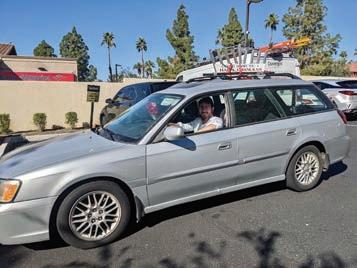
“This was a lifesaver for me. I wasn’t in a position where I was able to buy it, so that was just amazing.” JN
Six
Featured
Fighting Anti-Semitism: A Journalistʼs Lessons


Presenter: Annabelle Azade
Sunday, January 16, 2022 | 7:00 PM
Temple Solel, 6805 E McDonald Dr, Paradise Valley & Live Streamed Annabelle Azade is a native of France and graduate of the Sorbonne. She is a journalist based in Los Angeles, and has worked in Paris, Bangkok, New York City, Tel Aviv and London. Her talk, Fighting Antisemitism, A Journalist’s Lessons, will address the recent Anti-Jewish acts of murder of Ilan Halimi, Mirelle Knoll, Sarah Halimi in France and the disturbing Anti-Semitic acts of violence in the United States. This talk will be live in person at Temple Solel in Paradise Valley, as well as streamed online.
The Changing Face of Europe
Presenter: Ayaan Hirsi Ali
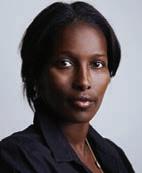
Sunday, January 23, 2022 | 7:00 PM | via Zoom
Ayaan Hirsi Ali is a Somali-born Dutch-American human rights activist, feminist, author of six books, scholar and former politician and host of the Ayaan Hirsi Ali Podcast. She addresses The Changing Face of Europe in this talk and her publications. Ms. Ali discusses how Europe, in the wake of mass migration, is turning the clock back on women’s rights. She wants Europeans to reform their broken system— and for Americans to learn from European mistakes before it is too late.
Supported in part by
Change is in the air at Temple Emanuel of Tempe. Rabbi Cookie Lea Olshein and Jessie Rubenstein, religious school director, both came aboard last summer ready to put their stamp on the community. Additionally, a new managing director might be in place early next month. In short, temple leadership is undergoing a transformation.
But change can make people nervous. Emily Schwartz, Emanuel board of trustee member, said she definitely felt some uneasiness at Emanuel's Chanukah party. “People are looking around and asking if things are gonna be different,” she said. “The answer is yes, and it’s good. It’s different and different can be really good without disparaging what was there before. Yes, this is different and it’s cool. You can feel the new vibe.”
Jennifer LeGrand, Emanuel’s president, who took over the helm just before the pandemic, agreed that change means new possibilities. “Having Rabbi Olshein as our spiritual leader is exciting, and Jessie is working on realigning curriculum and making improvements,” she said. “There’s a lot we can do to grow and serve more families in the East Valley. We work really well as a team.”
Growth is important for any synagogue, and LeGrand said the Reform congregation has seen an “influx of new members” over the last year. For Emanuel, which covers a large geographic area beyond Tempe — from Ahwatukee to Florence to the San Tan Valley — she called it “an amazing thing,” and highlighted efforts to build relationships with newcomers.

Olshein, who brings experience in increasing synagogue membership from her eight-year tenure as rabbi of Florida’s Temple Israel of West Palm Beach, said she is “excited to teach and learn and grow and lead and pray and help build this community up even more.”
Though COVID-19 precautions have made getting to know everyone more difficult, she emphasized that “the heart and soul of a congregation is all about relationships.”
To that end, she’s been “sitting down and talking to people, seeing what they’re interested in, figuring out what their niches are and being present in their lifecycle events,” she said.
Her focus is on kids and families without neglecting seniors or singles. “Every Jewish soul is valuable in a congregation and helping people find their passion, where to put their talents, helping teach them new skills, helping them lift themselves up — all of those things are important to building and retaining members and building meaning within a spiritual community,” she said.
Sarah Felix, first-grade religious school teacher at Emanuel and parent of two, said that Olshein is figuring things out. “There’s a culture here, but if people stop and take a moment you can see really nice changes happening to services, and our kids are excited to have her around the temple,” she said.
Felix was part of the search committee that hired Olshein and was struck by the rabbi’s thoughtfulness. “She really listened to what people had to say,” Felix said adding that quality will go a long way toward putting people at ease.
Olshein’s already put together a social justice focus group to formulate ideas about how congregants can advocate for real change. It’s one of her big priorities, and she’s found that people are very excited, both to build on existing programs like the Racial Justice Study
Action Center for Reformed Judaism.
In Florida, Olshein took congregants to meet with U.S. Sen. Marco Rubio’s district manager to ensure the senator understood his Jewish constituents’ stand on issues.
“We kept showing up every six weeks or so, and they learned what’s important to us. We didn’t always agree, but it was important for everyone to discover that sometimes we did,” she said. “We got to know the district rep so well that when he stopped taking notes about what was important, I’d say, ‘Don’t forget to write that down; keep a tally, because we want the people in D.C. to know these issues are important to our Jewish community.’”
She wants Emanuel’s congregants to take advantage of living near the state capitol and talk to their elected officials. “They are elected to serve us. It’s very Jewish to meet with them and share how our beliefs are lived in this world,” she said.
LeGrand is “thrilled with Rabbi Olshein and her focus on social justice and social action,” she said, and added, “We’ve never had a female rabbi and it’s exciting.”
Schwartz’s 7-year-old daughter agreed. When she learned the new rabbi was a woman, she exclaimed, “Mommy! I could be a rabbi?” It was “a really cool moment,” Schwartz said.
Rubenstein, meanwhile, has been “blown away every day by her teachers and the staff,” especially given how thankless teaching jobs can sometimes feel, she said. “These teachers are dedicated and passionate and genuinely care about what they’re doing.”
Rubenstein’s teachers feel the same about her. Felix said “Jessie’s background is phenomenal and her ideas for education programming are amazing. She has a new, fresh take on things that we haven’t seen in a while.”
After a decade as a Jewish educator, Rubenstein’s found that “when you let people teach what they’re passionate about, amazing things happen and it leads to the most incredible education for the students, the parents and the teachers themselves,” she said.
A particular passion of hers is meeting the needs of neurodivergent kids. As someone who was diagnosed with dyslexia late in life, she now wonders “how much
easier my life would have been if my teachers had known and been able to come up with strategies that worked for me. I don’t want kids to have to go through that.”
When it comes to Jewish education it’s even more important, she said, because “if students aren’t able to engage fully in the synagogue or religious school being who they are, and feel loved and accepted and cared about, they’re not going to come back.”
Emanuel teachers are “100 percent on board,” she said, adding that she has organized a number of teacher trainings on the subject, explaining what disability is and how it might show up in their classrooms. Gesher Disability Resources is a partner in this training.

“Any Jewish students should have access to a Jewish education,” she emphasized. “Period, end of story.”
Angela Sanders, the new clergy assistant, and Chelsey Falk, in her new role as religious school assistant, have been a big help, too. And “all I’ve heard from parents is how happy they are that we are bringing such a bright light to this and putting such a focus on ensuring equity in our Jewish education for all our kids,” Rubenstein said.
Anyone still wondering about the direction of Emanuel just had another chance to find out more at Olshein’s installation ceremony last weekend. Felix, who likes where things are going, gets right to the point: “Change is good, and it’s time for some new fresh changes at Emanuel.” JN
In largely rural Maine, some school districts don’t have enough students to justify creating a public high school. In order to guarantee that each child in the district is able to get a high school education, some of the state’s school districts make arrangements with public or private schools to take their students. Other districts allow students to choose where they want to attend school — whether inside or outside the state, or even outside the country. In either case, the state pays the student’s tuition. The one requirement is that the private school in which the student enrolls is “non-sectarian,” that is, that it doesn’t have a religious curriculum.
Last week, the Supreme Court heard oral arguments in Carson v. Makin, a case brought by parents of students who were denied tuition benefits to send their children to religiousaffiliated schools under the tuition grant program, and who contend that the Maine law violates the First Amendment.
Two recent cases in the Supreme Court make clear that states cannot use a school’s religious status as a reason to exclude the school from a generally available state program. And in one of those cases, the court held that under the free exercise clause of the Constitution a state may not prohibit students in a school choice program from selecting a religious school if they are permitted to choose other private schools.
But Maine argues that the religious
schools are excluded from the tuition program not because they are religious, but because they do religious things, including religious instruction. So, the argument goes, while the state may not refuse to use money in ways that benefit schools simply because they are religious, it should be able to refuse to provide funds that will be used by the schools for religious education. Maine takes this position, notwithstanding the fact that the excluded sectarian schools provide a fully compliant secular education program in accordance with state standards.
Based upon the questions and comments of the justices during last week’s argument, most observers anticipate that the court will uphold the parents’ challenge to Maine’s exclusionary practice. And although the decision will only have a direct effect on fewer than 5,000 students in Maine, it is likely to have a significant impact on education funding decisions nationwide.
Caron v. Makin has been called one of the “sleeper cases” on this year’s Supreme Court docket. It is a case that didn’t attract all that much attention as it made its way to the court, but is one that could have important and far-reaching implications on free exercise of religion issues, on issues relating to religious discrimination and on the important question of how states and school boards approach the issue of nonpublic school funding.
We anxiously await the decision. JN
RABBI MENDY DEITSCH
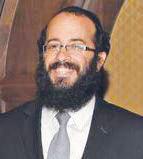
When we were young, my mother invited her Ob-Gyn to join us for a Friday night Shabbos meal.
He was a fine doctor and a proud Jew — a survivor of the Holocaust. He was thrilled to help bring children into this world.
During the meal he asked us kids if we knew about the Holocaust. We did. He then asked my brother and I the names of the concentration camps and we were only able to name two or three.
He was not happy.
He asked how my parents could bring
Recently announced French presidential candidate Éric Zemmour is an ultranationalist, right-wing pundit, who is anti-Muslim, anti-immigrant and pro-fascist. He is also Jewish.
Without that last fact we would quickly dismiss him as another political extremist. But the fact that Zemmour is an open, proud Jew — the son of immigrants from Algeria — makes it difficult to ignore him, since who he is and what he says are such embarrassments.
At the heart of Zemmour’s racist views is the adoption of assertions and accusations that have historically been used against Jews. He has simply repurposed them to attack different immigrants and minorities. And it is upsetting to see that his hatemongering is attracting voter attention.
France’s first round of presidential elections is scheduled for April. President Emanuel Macron, who has not yet announced his candidacy, is ahead in polls at around 24%. Zemmour registers at 14%, right behind far-right leader Marine Le Pen, at 19%. If both Zemmour and Le Pen stay in the race, chances are pretty good that they will split the far-right vote. Fear of that result might convince Zemmour to drop out of the race.
Zemmour’s ultranationalist and antiimmigrant ideology has led him into historical revisionism about France’s most shameful episodes of antisemitism. For example, he praised the Nazi collaborationist Vichy government and argued that it saved native-born French Jews from the gas chambers and only sacrificed foreign Jews. “Vichy
protected French Jews,” he said on TV to a country that still has not dealt with its role in the murder of Jews in the Holocaust.
And he minimized another sore point between France and its Jews by casting doubt on the innocence of Alfred Dreyfus, the French Jewish army captain who was falsely accused and convicted of passing secrets to Germany. The Dreyfus Affair was denounced as antisemitism tainting the highest levels of the French government. But according to Zemmour, both sides in the affair had noble motives, and he claims Dreyfus’ accusers were driven less by the fact that Dreyfus was Jewish, and more by the fact that he was of German descent.
Zemmour has been twice convicted of inciting racial hatred and discrimination. His two favored targets are immigrants and Muslims. He claims that France is involved in a religious war with Islam and a race war with its Black and Arab populations, and that immigrants and Muslims are the root cause of all of France’s problems.
During a 2020 debate, he said of unaccompanied child migrants: “They’ve no reason being here, they are thieves, they are killers, they are rapists, that’s all they do, they should be sent back.” And he rails against Muslim immigrants as “an invasion,” while asserting that “they should be given a choice between Islam and France.”
Zemmour’s hateful words are deeply offensive and troubling and would be so no matter who they came from. But they are particularly shameful when they come from a Jew whose family immigrated to France from North Africa. JN
up their children — I was 9 at the time — without a thorough knowledge of what had happened just a short 50 years earlier? My father simply smiled and shared how beautiful it was that we were learning in the yeshiva, studying Talmud and Jewish law, and sitting here celebrating Shabbos, openly, freely, joyously.
The doctor was not impressed, to say the least.
I have replayed this particular Shabbos meal in my mind many times over the years. I began to wonder why I don’t know more about this most horrific atrocity that befell my people, my family, just a few years earlier.
As I got older I understood that I actually know very much about the torture, hunger, suffering, killings and murder at the hands of the Nazis, may their name be obliterated. In fact, many of my neighbors, shopkeepers and the people I sat next to in synagogue had numbers on their arms and spoke to us about what they went through and the families they had lost.
Yet, the focus of our education was not on what the world likes to show or teach about Jews, mainly dead Jews and the persecuted, but rather on the living, breathing, vibrancy of Judaism.
My parents worked hard to instill in
us children the joy of Judaism — the heroism, the bravery, the eternity and the growth of the Jewish people — which is why we were sitting at a Shabbos table with 30 guests.
My father brought us to the Lubavitcher Rebbe to hear his talks and to be in his presence. The Rebbe is upbeat, motivating and uplifting.
The Rebbe, who survived the war, was alive. The Rebbe had joy and, at times, the central shul where the Rebbe prayed was electrifying. It was filled with forward motion, with a vision towards a stronger,
SEE DEITSCH, PAGE 12
We are a diverse community. The views expressed in the signed opinion columns and letters to the editor published in the Jewish News are those of the authors. They do not necessarily reflect the views of the officers and boards of the Jewish Community Foundation, Mid-Atlantic Media or the staff of the Jewish News. Letters must respond to content published by the Jewish News and should be a maximum of 200 words. They may be edited for space and clarity. Unsigned letters will not be published. Letters and op-ed submissions should be sent to editor@jewishaz.com.
At my school, this was practically unheard of. Teachers didn’t even know how to handle it. Once, my Hebrew instructor asked me in the middle of class if my father was “in the picture at all.” I was too ashamed to tell the truth, so I lied
things were harder for me to appreciate. What I did notice was how my best friends went to Florida every summer and on ski trips every winter. They received expensive electronics for Chanukah, whereas I got socks or magazines. I harbored intense
The older I got, the stronger this feeling became. It wasn’t until I started attending public high school that I learned my life experiences were normal, even common. I didn’t feel like such a freak anymore for not having two parents and not living in
myself without the context of recess was exciting to me — I even imagined my kindergarten friends would be jealous. This was a small, tight-knit Jewish private school, an oasis in an overwhelmingly goyish Midwestern town.
My mother parked in the empty lot at the front of the building. We grabbed our gloves and gardening shovels and got to work at the planting beds all over the property. We were there to pull weeds because we couldn’t afford to pay full tuition.
I wasn’t textbook-definition “poor” growing up, but I thought I was for a long time; this was mostly due to the fact I grew up with kids from more stereotypical Jewish homes. I was raised by a single mother who worked as a secretary. My father was a bartender and mostly absent.
SO MANY ASPECTS OF JEWISH CULTURE IN AMERICA COME WITH A HEFTY PRICE TAG: SYNAGOGUE MEMBERSHIPS, PRIVATE DAY SCHOOL, SLEEPAWAY CAMP, EXTRAVAGANT BAR AND BAT MITZVAHS. I WAS EXCLUDED FROM ALMOST ALL THESE THINGS THAT ARE CONSIDERED PART OF JEWISH LIFE.
and said that he was. I now consider myself working class. My mother’s income was definitely in line with that, but I had plenty of middleclass experiences growing up — private school, for one. Music lessons, braces, financial support through college: These are some of the myriad ways in which I am privileged. However, growing up, those

jealousy and was embarrassed of my background. One day, I was standing in the lunch line with a boy and he asked if my family owned a telephone. My friends noticed the differences in our lives; how could they not?
While I did love my school, I always felt a little out of place. It felt like I was always trying a little too hard to fit in.

ne of the many aspects of Jewish life in the Valley of the Sun, which drew me to Phoenix nearly 20 years ago, was the rich history of this dynamic community.
In 2003, when I arrived at Congregation Beth Israel, I felt an acute sense of humility knowing I was “standing on the shoulders” of the many great leaders that have served our sacred community. After all, the men and women of the Phoenix of the 1920s ultimately became the individuals who built many of the Jewish
institutions and organizations which are at the core of our community to this day.
OFrom the opening moments of our Kabbalat Shabbat at the Cutler-Plotkin Jewish Heritage Center on Oct. 22, we commenced the celebration of CBI’s 100th anniversary. Our centennial celebration marks the past, present and future. For the first time in over
70 years, CBI’s members worshiped on the consecrated ground of our first synagogue building.
The following weekend we marked the transition to the next 100 years — l’dor va’dor (from generation to generation) — as the opening letters of the Book of Genesis were placed on the first piece of parchment of the Centennial Torah
a big house in the suburbs. This is still something I struggle with, especially since there was a period of time when Jews were not permitted to join the upper ranks of society. But most of the Jewish community in postwar America was white, so they were able to assimilate,
SEE ROSEN, PAGE 13
we have commissioned in honor of our anniversary.
The idea for the Centennial Torah Project took form over the past two years as we put in place the plans to write our own Sefer Torah (Torah scroll), which
SEE KAHN, PAGE 13
WHILE WE COULD NEVER HAVE IMAGINED THE IMPACT OF COVID-19, THE ACT OF COMMISSIONING A SEFER TORAH DURING A GLOBAL PANDEMIC PROVIDED US WITH AN EVEN GREATER SENSE OF GOD'S HEALING SPIRIT AND ETERNAL TEACHING.
rebuilt Jewish nation.
There were the lessons of the past, yet, the focus was on the future.
Our eyes were trained not to look backwards but to share the vision for the future and the potential of the Jewish people.
Over the years, I have come to
appreciate this way of thinking much more. Not because what happened in the past is not important to learn from, but it is precisely because of the past and what we went through as a people that the need to reach out, uplift and be present for each brother and sister is essential to a thriving Jewish people.
It is not enough to be a proud Jew. That leaves the next generation, unfortunately, marrying outside the
religion and essentially ending the Jewish line of his/her family.
We need to live an inspired life, a happy life, to teach and inspire those of the religion to be an active Jew, a mitzvahfulfilling and proud Jewish person. This will keep us alive and thriving for a more meaningful life as individuals and as a people.
It is time we embrace the happiness of Judaism, the positive lessons and the
amazing opportunity that G-d gives us to connect to Him, to have a relationship with Him. How fortunate we are to be living in this generation where, through our actions, we will be able to see and feel the fulfillment and promise that Moshiach is here. JN
y father took to a certain custom when my brothers and I left for college. Before getting on the plane, he’d hug us close, and in his serious voice, he’d remind us, “Remember who you are.”
We are always warned that we will someday become our parents. Low and behold, the other day when I dropped my son off for preschool I found myself holding him close, and speaking softly into his not-so-little-anymore ear, “Remember who you are.”
He laughed, shrugged out of my grasp and ran off to play.
Moments of transition come at their own speed, at a pace that we can rarely control.
Life is like this. It passes us by so quickly.
In this week’s parshah, Jacob, lies on
ROSEN CONTINUED FROM PAGE 12
unlike other minorities. For example, the affluent neighboring suburb of my hometown (and its country club) had a history of not allowing Jews to live there. Now, this neighborhood is extremely popular for the local Jewish community; it even has a Chabad.
I now know that I am not an anomaly. While we are a particularly well-off minority group, it is an antisemitic assumption that all Jews have a lot of money. That said, I do think my experience is part of a larger problem.
So many aspects of Jewish culture in America come with a hefty price tag: synagogue memberships, private day school, sleepaway camp, extravagant bar and bat mitzvahs. I was excluded from almost all these things that are considered part of Jewish life.
I will never forget when a couple of young, energetic counselors came to my Sunday school to give a presentation on the closest Jewish sleepaway camp. They made it sound like the best place on earth (in fact, I’m sure they said those exact words), and played a heartwarming video displaying the beautiful campground and joyful activities. I was so excited to go. I daydreamed for weeks about it. But my mom later told me that I was rejected from a scholarship to attend the camp, so there was no way I could attend. While it wasn’t traumatic, that’s hard for a young kid. And in a way, it’s followed me into adulthood. I’ve seen other Jewish people
his deathbed and looks out at his family. He gives each of his sons a final blessing. Carefully and individually, for each of his children, he recalls the successes and challenges of their lives. It is as if he is saying to each one, before taking his last breath: “Remember who you are.”
MVayehi literally means “and he lived.” While Jacob knows that he does not have any more time to make different choices or new plans, his sons do. Perhaps his blessings are meant to hold up a mirror to his sons, saying: This is the life you have lived so far. How will you be authentically you in the time you have left?
As American Jews, we celebrate two New Years — one religious, one secular. This gives us multiple Vayehi moments, opportunities to consider our lives lived so far. On our Jewish New Year, we participate in cheshbon hanefesh (an accounting of the soul). And on the secular New Year we have the chance to ask ourselves, are we our best selves as we were on Rosh Hashanah? Have we remembered who we are?
Cheshbon hanefesh is not a once or twice per year responsibility. It is upon us each
day to reach our true selves, living lives that are worthy of blessing.
After blessing his sons, Jacob turns to his grandsons, Ephraim and Menasseh. He promises them greatness: “By you shall Israel invoke blessings, saying: God make you like Ephraim and Menasseh.” We as a people have stayed true to this promise. Traditionally, even today, the blessing for a son includes the words: Y esimcha Elohim k’Efraim v’chiMenasseh.”
Jewish liturgist and feminist, Marcia Falk, adapts this blessing for us. If we wish for our children to maintain their authenticity in moments of triumph and moments of challenge, let’s address this directly. Instead of invoking biblical figures, she offers:
To my child: Be who you are. And may you be blessed in all that you are.
In my home, when my husband and I bless our children we use a hybrid model: To our sons, may you be like Ephraim and Menasseh. To our daughter, may you be like Sarah, Rebecca, Rachel and Leah. Then we add: But most of all, may you always be you.
KAHN CONTINUED FROM PAGE 12
bond over similar memories that I don’t have. Even now, I feel disconnected as a young adult who wants to be a part of the Jewish community but is not sure where I fit in.
Still, the Jewish community has been there for me. When I was in college and needed a job, I taught Sunday school at the temple I grew up going to — even though I hadn’t regularly attended for years, wasn’t a member and couldn’t afford the fees. They gave me a membership at no cost. I was welcomed back into the fold. My father died when I was 20, and many in the community reached out to me, including my rabbi. Through that job, I became close friends with another teacher who had similar less-than perfect experiences with Jewish institutions, and it was something we bonded over.
While I have once again grown distant from Judaism (mostly due to the fact I no longer teach Sunday school and couldn’t attend services due to COVID), I know it will be there for me when I come back. Some things in the Jewish community may not be accessible to everyone, and that should be addressed. But in my experience, the most important things — support, acceptance, tradition — can always be found there. JN
Rachel Rosen has worked in marketing for nonprofits since graduating from college with a political science degree in 2019. For more articles like this, visit heyalma.com.

would be celebrated and embraced by future generations of our congregational families. While we could never have imagined the impact of COVID-19, which delayed our celebrations by one year, the act of commissioning a Sefer Torah during a global pandemic provided us with an even greater sense of God’s healing spirit and Eternal teaching; the salvific nature of the Torah itself gave us hope in the darkest days of the past two years.
Writing a Torah is a once in a generation mitzvah and our campaign to commission a new Torah is an act of unrequited love for the Jewish people and our beloved congregation. This Centennial Torah embodies the very essence of our moment of transcendent celebration. It is the epoch story of our people’s past, our guide for daily living and our hope and faith in the future.
Over the course of the past two months, I have stood in awe, watching our families, along with our religious school and preschool students as they sit with our sofer (scribe) and write the first letters of Genesis. Our sofer sits patiently with every grandparent, parent and child to teach them the true meaning of fulfilling this mitzvah. With each stroke of the kulmus (quill), our children sit still and our adults are mesmerized, seeing themselves as active participants in the ongoing revelation which began at Mount Sinai over 3,200 years ago.
Perhaps this is what Jacob meant by this final, last-breath-blessing to his children and grandchildren: “Be you, boys.” May you always be you.
With 2022 approaching, we assess our lives as we have lived them so far. We scrubbed our souls clean on the High Holidays, and we recognize now where they might need just a little polish. Have we stayed authentic? Have we stayed true? With another New Year upon us, may you always be yourself. May you always remember who you are. JN
In these singular moments, as ink touches parchment, we witness a moment of transcendence as the seeds of Torah are planted for the minds and spirits of coming generations. In these moments, we can envision the Jewish women and men of the next generation who will make this Torah their very own “Tree of Life.” I hope they will find God’s presence in this Centennial Torah and know how very connected we are to them through this act of love for God, Jewish living and the Jewish people.
In 1950, at the consecration ceremony for CBI’s second location downtown, my predecessor Rabbi Abraham Lincoln Krohn (z”l) shared this eternal truth which has humbled me over the past two decades:
“The essence of its [Torah’s] being, the secret of its power, the meaning of its message and the gallantry with which it has defended the goal of all its striving, have remained constant…[Thus] we celebrate, the continuity from faith to greater faith in the enduring search of [every Jew] for God.”
I pray that 100 years from now, when CBI celebrates is bicentennial anniversary, our grandchildren and their grandchildren will understand that our Centennial Torah represents our hopes, dreams and love for them. JN
Stephen Kahn is senior rabbi at Congregation Beth Israel.
Rabbi Moshe and Sashie Levertov were directing the Aleph-Bet Preschool & Kindergarten in Phoenix and raising their four kids, all between age 8 months and 6 years, when Sashie was diagnosed with leukemia at age 27 in January 2012.

“It was out of the blue, and our life immediately, completely changed,” Sashie said. “Our health is something we count on. We feel safe when we have it but as soon as our health is challenged, our whole foundation of safety is totally gone and everything, everything just feels impossible.”
It was a long recovery, and they are grateful every day for the role their support system played. They had assistance from people they knew and loved, like their family members, and even from people they didn’t know and never met. But they recognized that many others don’t have a large support system — if any at all.
Last year, the couple launched the Jewish Care Network to ensure that people don’t face an illness alone.
“We’re grateful every day for the community that we had back in 2012 that literally rallied around us and helped us with everything from making sure my kids had lunch, or a play date, or we had a warm dinner waiting for us when we got home from the hospital,” Sashie said. And support takes a variety of forms.
“Whoever you are, you can help someone in this situation,” she said. “No one should sit at home and say, ‘This is happening, but I can’t do anything about it.’”
Since launching the nonprofit last year, the couple has hosted events for volunteers to get together and prepare Shabbat boxes. Every week, Moshe, Sashie or a volunteer brings Shabbat boxes to area hospitals. If there happens to be a Jewish patient, they get a box full of all the essentials. Sashie says it shows
Mid-Atlantic Media, a fast-growing publisher of niche community and ethnic titles, is seeking to add an editor to lead its full-time publishing project Phoenix Jewish News in Scottsdale, AZ .
We’re looking for a leader who is connected and will be involved in the fabric of the greater Phoenix Jewish community. An editor that can help elevate Phoenix Jewish News' visibility, awareness and journalistic quality. An editor that can lead with a digital news approach and deliver our bi-weekly print product. An editor that can work through copious amounts of copy and serve as a mentor to develop sta and freelance writers. The ability to juggle multiple projects, and the willingness to help shape multiple publications and their online experience is a must. Occasional travel will be expected. Familiarity with the Jewish community is a plus.
This is a high-energy position and comes with the opportunity to shape how tens of thousands of Jewish readers across the greater Phoenix metro area digests news and features.
• Must have strong familiarity of Jewish community
• 3-to-5 years of community news experience
• An ability to edit quickly and accurately in a fast-paced, deadline-driven environment
• Strong people skills and an ability to manage and motivate a team
• Digital/Technical aptitude, including comfort with WordPress, Photoshop, and digital photography and social media.
• Ability and willingness to wear many hats, from high-level editorial strategy down to shoe-leather journalism and in-person community engagement
a patient there’s a community that is thinking about them, even if they don’t know their name.
They’ve also hosted an event for volunteers to bake challah and cook large quantities of chicken soup in preparation for last-minute deliveries. “People don’t necessarily know when they’re going to be thrown into this,” Sashie noted.
Volunteers can help bring patients to and from appointments, and also make phone calls to people going through an illness to ask how they are doing and find out what they need, if anything.
People going through an illness can also receive spiritual counseling from Moshe.
“Everything is tailored to each specific patient and what they’re going through,” Moshe said. “Every medical crisis is different. Even if the diagnosis is the same, every person is different.”
Moshe came up with the idea for the nonprofit about a year into Sashie’s recovery.
He was so moved by the outpouring of community support he and his family received during Sashie’s illness, he wrote a thank you letter to the Jewish community, published by the Jewish News in October 2012.
“I can assure you that each action that was taken, every good deed that was done, and each sincere and genuine offer of support has literally and physically helped and enabled us to be where we are today — thank G-d — slowly, but surely, moving in the right direction,” he wrote.
But they weren’t able to start an organization just yet. In 2013, they ended up moving to Pittsburgh. Sashie’s youngest brother, who is also her stem cell donor, was getting married.
Sashie’s doctor gave her permission to get on an airplane to travel to the wedding, but he didn’t feel safe letting her return on an airplane. “It was a one-way go-ahead,” Sashie said. So, they ended up living in Pittsburgh, near Sashie’s family, for six years, the bulk of which she spent recovering.
“But ultimately, Phoenix was home,” Moshe said. They knew they wanted to start JCN when they moved back, so they timed it all when things felt right
with Sashie’s condition. They moved back to Phoenix in August 2019.
They hope to grow their volunteer base, currently at around 20, to create a community that positively impacts the quality of life for patients and their families with social, emotional and tangible support.
“We are very blessed, and we could not have done this alone. So nobody should,” Sashie said.
Two days after her diagnosis in 2012, Sashie remembers asking her doctor what she could possibly do to survive, in addition to the medical treatment she would receive.
“The thing the doctor said to me that sticks with me forever, because you can apply this to every aspect of your life, is to stay active and stay positive,” she said.
It is easy to feel scared and completely lost when facing an illness, Moshe said, and knowing a community is out there reminding you that you’re not alone adds a lot of positivity.
“It’s literally that one act or connection that makes a difference,” he said. “It doesn’t have to be something that someone signs up to do once a week for the next year, it’s just every single connection makes a big difference for someone going through something.”
Moshe and Sashie said their kids — now 15,14,12 and 10 — have learned a lot from their family’s journey.
“It has been an incredible blessing for us to be able to experience and to be able to show our children that you can get through challenges and grow from them and learn from them and help others because of them,” Sashie said. JN

 ERICA ERMAN
ERICA ERMAN
Marian Wright Edelman, founder of the Children’s Defense Fund, famously said, “We must not, in trying to think about how we can make a big difference, ignore the small daily differences we can make, which, over time, add up to big differences that we often cannot foresee.”
Over the past few weeks, students in Congregation Kehillah’s Youth Education Program (YEP!) have been taking that sentiment to heart while they have been learning what it means to treat every human being as equal and created b’tzelem Elohim, in the image of G-d.
Sometimes it is hard to remember we are all children of the same parent, G-d, when we see others who are very different from us and live different experiences than us. In a recent session of YEP!, our middle schoolers focused on the homeless in our own Maricopa County, which has roughly 7,500 homeless, not including hidden homeless people — individuals or families who live with other families or friends.
The kids learned about stereotypes of the homeless population with a true or false game and then got ready to do a mitzvah: Middle school students wrote short positive notes to include in hygiene bags and then they
assembled 40 bags with combinations of socks, shaving cream, soap, shampoo, lotion, deodorant, candy, granola bars, goldfish, washcloths, toothpaste and toothbrushes, floss, etc. Kehillah donated all of it to Mom’s Pantry, a charitable organization fighting hunger.
According to Jacqueline Schatzberg, a YEP! sixth grader, “When we were learning about b’tzelem Elohim we talked a lot about homelessness in our area. I was excited to find out that I could do something to help make a difference in my community. This project made me really feel created in the image of G-d. G-d made miracles and these bags for the homeless were a miracle for them. After the mitzvah project, I felt very happy. I felt this because I knew that I was doing something good for someone.”
Seventh-grade twins, Brian and Eli Hemmert, also participated in the project.
“We think it is very special to help people who are truly in need. We are sharing our fortunate blessings with the people who are less fortunate.” Brian and Eli’s mom, Cari Brodsky, said, “I am so proud of them for achieving another mitzvah.”
As a YEP! teacher, I, too, loved planning the program with my students. Seeing

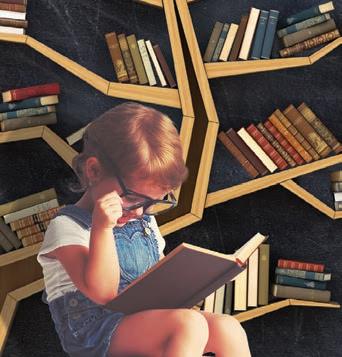



our students light up knowing they were doing a mitzvah was incredible. Every student was engaged, thoughtful and had a wonderful time. What made our project truly special was that YEP! students learned not only the importance of helping the homeless and needy in our community, but why it is important to do so: because every one of us is created b’tzelem Elohim and we have responsibilities to our families, our synagogue, our communities, our state and our country.
Prior to the mitzvah project, students wrestled with the idea of what it means that all human beings are created b’tzelem Elohim. If we do not believe that G-d has a human form, what can it mean to be created in the image of G-d? The students discussed different qualities that G-d has that we can emulate — kindness, strength, doing what is right, caring for one another, thinking and using the minds that G-d gave to us and more.
Along the way, the students had an opportunity to brainstorm questions they have for G-d. Some of the questions asked included: Why does G-d create viruses? Why did G-d create mosquitoes? How did G-d come to be?
YEP! teachers love and encourage these

types of questions, and are proud of their students for thinking critically and having giant hearts. As children of Israel, it is our heritage to question, wrestle with God and ask hard questions. Part of what was so powerful about this unit is that our students learned that sometimes we can be mad at God, and that is perfectly kosher and OK; we get mad sometimes with those we love. The important part is recognizing we have a relationship and working to make it stronger.
Mitzvah projects like this one help bring our community together and remind us that there is so much good we can do in this world and in our own communities at home.
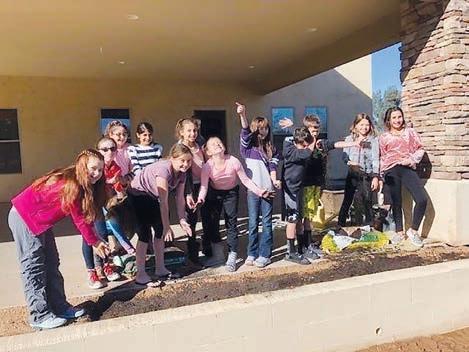
One of Rabbi Bonnie Sharfman’s favorite quotes is “Rabbi Tarfon taught: It is not your responsibility to finish the work [of perfecting the world], but you are not free to desist from it either.” (Pirkei Avot 2:16).

Yasher koach YEP! middle schoolers! JN
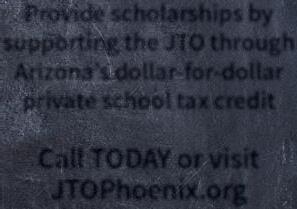

Erica Erman is Congregation Kehilla’s YEP! middle school program’s Judaica, music and tefillah teacher. She is also one of Congregation Kehillah’s two cantorial soloists.
Eleven months into 2021, the words COVID and coronavirus have assumed a dominant place in the international vernacular.
I know I’m not alone in wishing we could find another word to take its place and, at the same time, wipe away its deep and too-often shattering impact. Even The New York Times tried to make sense of it all with this headline: “Pandemicrelated terms have permeated everyday speech, yielding dictionary updates and slangified phrases. But what about after coronavirus?”
Hopefully, as we continue our slow climb out of what has become a lifechanging dynamic, we can put some distance between our lives and COVID’s consequences. And, maybe a new generation of post-pandemic terms will become clearer.
Until then, from our perspective at the Alliance of Arizona Nonprofits, in addition to ensuring we all stay safe and healthy, our focus remains steadfast on the impact of COVID on nonprofits across Arizona and how we can help in their recovery.
An Alliance survey of nonprofits statewide earlier this year showed a total pandemic-driven revenue loss of more than $91 million, a 52% drop in year-end giving and an increase of more than $15 million in expenses, primarily for PPE, supplies and technology.
And, though a more recent survey reported nonprofits were adopting a cautious return to in-person events, which are so important in fund-raising strategies, the fact remains that agencies doing great work in communities statewide continue to struggle.
During COVID, many individuals, foundations and grant-making organizations loosened application requirements and approved a greater number of unrestricted gifts rather than designating them for specific purposes.
The Jewish Telegraph Agency, in coverage of a Jewish Funders Network survey, reported that “more than threequarters of the group’s survey respondents said they had increased their giving in response to the pandemic” in addition to considering “new causes,” including “support for basic necessities like food and shelter.”
Local Jewish federations also boosted their giving during the pandemic. JTA reported that the Jewish Community
Foundation of Los Angeles distributed $14 million in COVID response grants. The UJA-Federation of New York “distributed nearly $64 million in COVIDrelated aid on top of its regular grants of $133 million.”
In Arizona, the Jewish Community Foundation of Greater Phoenix, in its first round of distributions in 2020, awarded COVID emergency grants totaling $69,000.
Every dollar contributed to nonprofits is critical, especially at a time when their services and resources are stretched so thin by the unexpected and potentially devastating effect of COVID, which also resulted in job losses among those doing the work.
As we come into the holiday season, when giving is historically higher than during the rest of the year (even though needs remain high across the entire calendar), we encourage you to do whatever you can to help those in need be able to survive. And so much of that falls to our nonprofits.
At the same time, we want to point you towards April 5-6, when the 24-hour Arizona Gives Day fundraising campaign unites nonprofits, big and small, new and established, and celebrates and increases philanthropy in
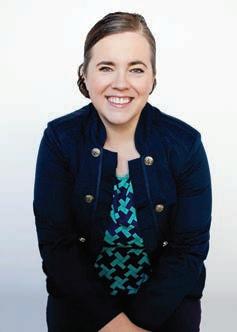
Twins Eli and Brian Hemmert of North Scottsdale weren’t sure what they wanted to do for their b’nai mitzvah project — until Aug. 27.
That day, two suicide bombers along with gunmen attacked crowds of Afghans in Kabul, Afghanistan’s capitol. The victims were flocking to Kabul’s airport preparing to flee the Taliban takeover in the runup to the U.S. withdrawal from the country. At least 60 Afghans and 13 U.S. troops were killed.
“It was sad to see how people had been there for so long and they couldn’t get to come back home,” said Eli, 13. “And people had been helping our military, and we wanted to help them back.”
The Aug. 27 tragedy inspired the Hemmerts to find a local charity that helps refugees. With help from their mom, Cari Brodsky, they found the Tempe-based Welcome to America Project.
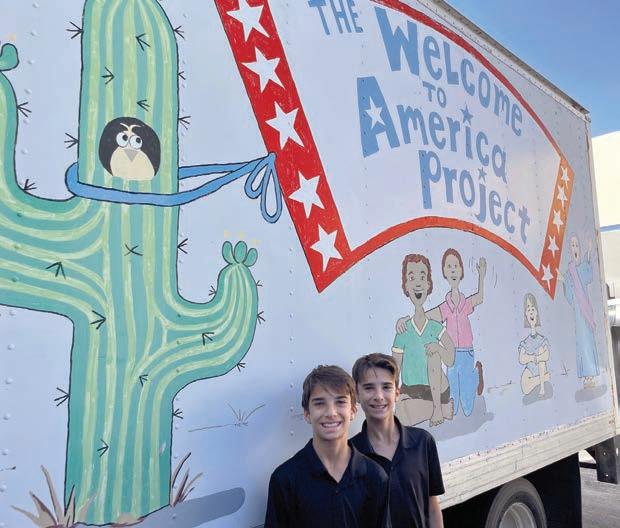
According to the Arizona Department of Economic Security, 2,060 Afghan evacuees have been approved to resettle in Arizona by the end of next March.
In September and October, Eli and Brian collected donations to create and deliver 30 hygiene kits with basic necessities like toothbrushes, razors, shampoo, deodorant and soap to the nonprofit. Many Afghan evacuees have not arrived in Phoenix yet and the kits will be waiting for them.
The nonprofit helps refugees from all over the world. Brodsky, Eli and Brian spent Saturday, Oct. 30 helping a refugee family from Congo get set up in an apartment, after having lived in a tent for 15 years in an African refugee camp.
“It’s a really good feeling knowing that you’ve helped people who really need help,” said Brian.
Eli said the experience made him reflect on his Jewish heritage.
“Our Jewish ancestors were helped as refugees into the United States, and now we’re helping other families similar to ours,” he said.
Brodsky had long shielded Eli and Brian from the horrors of the world. For many years she did not watch the news in front of her children. But in the last year or so,
she’s worked to integrate them into an awareness of the world around them.
This mitzvah project “opened my eyes,” Eli said, to what other families go through in other countries “and how much we have and how much other people need.”
Brodsky is proud of her sons, and hopes they realize the importance of taking pride in their Judaism. “And I hope that they realize for the rest of their life that giving is a mitzvah — and it rewards you just as much as it helps somebody else.”
Rabbi Bonnie Sharfman of Congregation Kehillah said the Hemmerts identified a “great cause within the community,” and is proud of them for not just collecting items but actually “putting themselves personally into the picture.”
Speaking directly with people from different journeys and backgrounds helps to foster compassion and understanding, Sharfman said.
Arizona through online giving.
Arizona Gives Day helps raise awareness about the critical role Arizona nonprofits play in our communities and inspires people to give generously to create a thriving and stronger Arizona for all.
Last year, during a time excessively described as “unprecedented,” Arizona donors opened their hearts to donate a record-breaking $7.1 million for nonprofits across the state. Since 2013, Arizona Gives Day has raised more than $30 million for nonprofits statewide.
Through our website, AZGives.org, we have added features to encourage and streamline year-round giving on a platform that also offers an advanced search filter to find nonprofits by specific criteria, area of focus and which donations may qualify as an Arizona tax credit. Among our members are Hillel Jewish Student Center, Jewish Family & Children’s Service and Jewish Free Loan.
However you decide to give, please know there are thousands of men, women, children and families in Arizona who are grateful for whatever you can do for tzedakah. JN
As she works with students through the bar mitzvah process, she emphasizes how to relate aspects of the Torah and their learning in general to things they care about in the world around them.
“Part of accepting responsibility, of being an adult Jew, is also helping to alleviate suffering when you can in the world,” Sharfman said. JN

is the season to ask for tax credits. Every eligible organization is making their plea. I know most of the Jewish organizations and their leadership, and they all do avodat kodesh, holy work. I encourage you to support them.

As you know, every dollar counts, and your donation ensures the viability of a vibrant Jewish community.
So, why donate to the East Valley Jewish Community Center?
It’s far, there is another JCC and I haven’t heard about the EVJCC anyway.
Allow me to tell you about us. The EVJCC is not a typical JCC, we do not have a gym or a pool.
We are so much more.
First of all, we do not have membership dues — everyone is welcome and everyone belongs. In fact, we consider everyone a member of the EVJCC.
Our J is a center for Jewish engagement — providing hours of classes every week about Jewish text, history and culture. I invite you to participate in our classes. Due to the COVID-19 pandemic, they are completely virtual and you are welcome to join us. In addition, we offer programs on art, culture, parenting and genealogy — just to mention a few.
Our Klezmer Fest attracts hundreds of participants annually, along with our Israeli movies series, concerts, lectures about Israel and our Lone Soldier support program.
Our JBox program provides free meals to low-income families, free lunch and snacks to low-income children enrolled in our childcare. We recently expanded this project by opening a food pantry to fight food insecurity.

Relationship Engagement department, interacts with diverse faith, ethnic and community leaders throughout Greater Phoenix. We hold interfaith dialogue and discussions, conversations about race relations and interactions with political leaders here in Arizona. The Conversations with the Rabbi podcast, available from our website, shares some of these exchanges and you are welcome to listen anytime.
‘TThe Holocaust Education and Human Dignity department raises awareness of the Holocaust and the dangers of intolerance and hate. For the past 20 years, we have offered workshops to teachers, academic lectures, theatrical performances and art exhibits to the public and schools. Most recently, we added Auschwitz Virtual Live Tours, led by a docent from the AuschwitzBirkenau Memorial and Museum. These tours are available for individuals and groups. Since we began these tours in March, we have provided Holocaust education to 16,000 people around the world. Additionally, we are working directly with school districts to provide these tours free of charge to their students in our effort to increase Holocaust education among the youngest generations.
You may have noted that I am not only the CEO of the J but also a rabbi. Why would a JCC hire a rabbi? Again, we are not your typical J.
As the rabbi of the EVJCC, I have been able to counsel and support members of our Jewish community who may not have anywhere else to go. I’ve been present for families to officiate weddings, funerals and support interfaith and unaffiliated families during life cycle events. I’ve conducted chaplaincy work for Jewish patients at various health care facilities not in the network of any Jewish agency. During COVID, I counseled countless seniors who felt alone, confused and scared. Without these sessions, these seniors may have been left without anyone to speak with or with whom to share their fears.
Yes, we are in the East Valley and you may not live nearby. But there are others — Jews and non-Jews alike — who benefit from our work.
Your tax credit donation is a sign that you support our work and our Jewish community. We are blessed to have a broad Jewish community, and when all its segments are thriving, we are all thriving; when each of us is strong, we are all strong.
So, please support all the Jewish organizations you are able to as we are all doing avodat kodesh. And please remember the EVJCC. JN

Now that the Chanukah parties are over, it’s time to assess the mess and clean it up. The easy part is tossing out the cups, bottles, cans, plates and decorations. The hard part is removing the wine stains and degreasing the stove from all the latke and jelly donut preparation.
A spill or two of red wine is highly likely. By now, it has dried, and therefore, the cleanup becomes more difficult.
If you Google instructions on removing red wine stains, your search will yield an overwhelming amount of results. How do you know which one is effective? We suggest the following do-it-yourself steps to remove a wine stain.
• Saturate the stain with straight club soda. Use enough to see the carbonation bring the color to the surface.
• Blot with a clean white towel until you can’t pick up any more color.
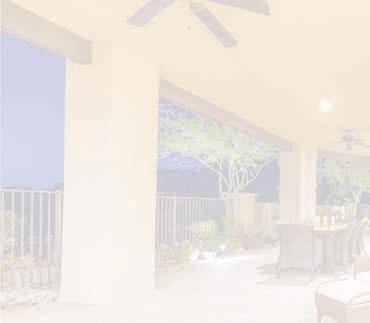
• Pour a layer of salt on the stain.
• Let it dry completely.
• Brush up the salt with a spoon or ladle.
• Vacuum the area.
This method is safe for all types of carpets. If you do not achieve the desired results, don’t bother to try again. Call a professional carpet cleaner.

Phoenix Carpet Repair & Cleaning, a Rosie certified partner, suggests a product it uses to professionally clean carpets: Pro’s Choice Red Relief. This product can be purchased online at most hardware and janitorial stores. Follow the manufacturer’s instructions on the bottle. You may have to buy a few carpet cleaning tools to get the job done.

Note that every time you add a remedy to the carpet, it will create more stains. The key is rinsing. A professional carpet cleaner will do a proper rinse that will restore the pH balance and remove residue. Hot water extraction (steam cleaning) is the most effective way to remove wine stains.
If you go the DIY route, test carpet stain removal techniques or new products in a hidden area to see the results. Sometimes a
brighter surrounding area will form, which can make the formerly stained area stand out. If the stain does not come out, you can replace the carpet. If that’s not an option, hire a professional to cut out the damaged piece and replace it with a new matching section. As a last resort, rearrange the furniture to hide the stain.
Cleaning upholstery
You have to be very careful about upholstery. There are many variants of fabric, color and stain protection. If the furniture is covered with a machine-washable slipcover, remove it and wash per the instructions on the tag. Otherwise, call a professional upholstery cleaning service.
Cleaning stone surfaces
To remove wine stains from tile and grout, liberally sprinkle baking soda on the stain. If the tile and grout are not sealed, it should draw out the moisture and color. Sprinkle, set, sweep up, repeat until you can’t pick up any more color.
When granite and stone countertops are properly installed, they are carefully sealed so that regular cleaning can be done with mild, warm or soapy water. After washing and drying, polish the surface with a microfiber cloth. Engineered stone is tougher and more scratch resistant, but the same daily regimen of soap and water works best on these counters, too.
Cleaning the oven and range
Between the brisket, latkes and jelly donuts, your oven and stovetop may be a greasy mess. You have a few options to clean them:
• The oven’s self-cleaning cycle . The process generates a lot of heat, so run it on a cool day. First, wipe up loose soil in the oven and remove the racks and pans. Follow instructions in your appliance’s manual. Newer ovens may let you set a shorter cleaning time. Don’t leave the house while cleaning is going on.
• Store-bought oven cleaner. instructions carefully and wear rubber gloves, goggles and old clothes for this messy job.

• Baking soda and vinegar homeowners complain it’s difficult to get the baking soda off the oven afterward. At any rate, mix a couple spoonfuls of baking soda with water to create a paste to spread over the walls of your empty oven. Let the oven sit for 12 hours (the paste may turn brown). With a wet rag or sponge, wipe out the paste. Use vinegar to sponge surfaces where the baking soda gets stuck. Use the baking soda on the oven’s window and let it sit for 30 minutes before removing it.
• Straight ammonia . Try this only on electric ovens. Warm up the oven to 150 degrees F. Turn it off and put a half cup of colorless ammonia in a bowl on the top shelf and a pan of boiling water on the bottom shelf. Close the door and let the oven sit overnight. The next morning, wipe the oven clean with a mixture of ammonia and a little dish soap.
• For the stovetop, follow the guidelines as outlined in the appliance’s manual if you plan to use a store-bought item. Some products are too harsh and can scratch the surface. A steam cleaner works well and does not use any chemicals. Exercise caution when using a steamer as you can easily burn yourself from the steam.
Over time, grease, soap scum and food debris build-up in dishwashers. The appliance becomes less efficient and can get a little too aromatic.
Remove the bottom dish rack and clear the drain of any debris. Then run a hot water cycle in the dishwasher with a cup of white vinegar sitting in a sturdy container on the top rack. This will wash away odors and grime. After
the cycle finishes, sprinkle a handful of baking soda around the dishwasher’s bottom and run a short cycle using hot water. It’s also possible to buy a bottle of dishwasher cleaning fluid at the grocery store. Just put the bottle on the top rack and run a hot-water cycle in the empty dishwasher.
After a cleaning cycle, wipe the inside of the dishwasher with a clean towel to remove residue left behind.
Fingerprints get everywhere. Slightly dampen a microfiber cloth or regular towel with water and then apply stainless steel cleaner to the cloth. Polish the surface and wipe it dry with another dry cloth or towel. Don’t apply a heavy coat of cleaner onto the appliance surface even though directions on the cleaner may say so. This toweling method works faster, is less messy and will save on costs of the cleaning compound.
Once you get your kitchen back to its pristine condition, you can mess it up again with a New Year’s Eve party! JN
Rosie on the House is an Arizona-based, home improvement, syndicated radio program that airs every Saturday morning from 8 a.m.-11 a.m. on KTAR News 92.3.
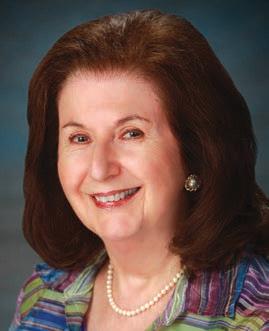






Dara Horn
W.W. Norton & Company (2021)
ara Horn ends the introduction to her new book, “People Love Dead Jews,” with the hope that her readers “find it as disturbing as I do.” What she wanted to write, though, was something more direct: that she hoped her readers would “hate it as much as I do.” Horn told a group of Jewish journalists gathered to discuss her book earlier this month that her publisher made her soften her words.

at was the right decision, as “disturbed” is a much more accurate way than “hate” to describe how a (Jewish) reader will react to Horn’s essays that, in the author’s words, cover “the endless unspoken ways in which the popular obsession with dead Jews, even in its most apparently benign and civic-minded forms, is a profound a ront to human dignity.”
“I wish I did not feel the need to do this,” Horn writes in her introduction. “But I want my children, and your children, to know.”
Horn, a novelist whose stories center on Jewish characters and subjects, turns essayist in her newest tome as she re ects on the world’s fascination with Jews who have died and its collective shrug when it comes to Jewish life. e 230-page collection of essays is the most astute, sensitive and honest book I have read about antisemitism.
Horn’s writing style — unabashedly frank, smart and even funny at times — serves as the perfect vehicle for her two central theses: People tell stories about dead Jews that make them feel better about themselves; and Jews must erase some aspect of themselves in order to gain public respect in non-Jewish societies.
Horn begins the book with a chapter called “Everyone’s (Second) Favorite Dead Jew,” an exegesis on the world’s obsession with Anne Frank. Horn doesn’t waste time making her point. By page 2, she jars the reader awake by contrasting the popularity of Frank’s diary (it has sold more than 30 million copies) and tours of the house where she was hidden, with a disconcerting incident that occurred in 2018. A young man who worked at the Anne Frank house was told by his employers to wear a cap to conceal his yarmulke. e leaders of the museum were seeking “neutrality,” they said, and a Jewish
worker wearing a kippah might “interfere” with the museum’s “independent position.” It took four months for the museum to nally agree to allow the kippah in public, “which seems like a rather long time,” Horn writes, “for the Anne Frank House to ponder whether it was good idea to force a Jew into hiding.”
DIn a later chapter, “Blockbuster Dead Jews,” Horn writes of last year’s comprehensive exhibition, “Auschwitz: Not Long Ago, Not Far Away” at New York’s Museum of Jewish Heritage, and expounds on the proliferation of Holocaust museums and memorials across the U.S. in the 1990s. She writes: “ e idea was that people would come to these museums and learn what the world had done to the Jews, and where hatred can lead. ey would then stop hating Jews.
“It wasn’t a ridiculous idea,” Horn continues, “but it seems to have been proven wrong. A generation later, antisemitism is once again the next big thing, and it’s hard to go to these museums today without feeling that something profound has shi ed.”
As she notes the breadth and detail of the “Auschwitz” exhibit in New York, Horn wonders what its purpose is. While the “o cial” answer is “Everyone must learn the depths to which humanity can sink,” Horn worries that, instead, it sets the bar “rather high” when it comes to dangerous Jew hatred. “Yes, everyone must learn about the Holocaust so as not to repeat it,” she writes. “But this has come to mean that anything short of the Holocaust is, well, not the Holocaust.” Like a lone wolf shooting people in a synagogue.
In the chapter, “Commuting with Shylock,” Horn lays bare the strained e orts of English professors to prove that Shakespeare’s “The Merchant of Venice” is not antisemitic — when it clearly is. I can attest this is a real phenomenon. In both Shakespeare classes I took as an undergraduate, the instructors stressed Shylock’s “Hath not a Jew eyes?...If you prick us, do we not bleed?” monologue as proof that the Bard was saying that Jews were just like everyone else. Horn writes that she also handed this explanation to her 10-yearold son while listening to an audio version of the play. e child, in response, laughs: “You seriously fell for that?”
“ ere is a terrible bond at work here,” Horn writes, “tying us inexorably to a long history of ugly caricatures and spilled blood. And there is also a much subtler and more insidious bond, tying us to the need to justify it and accept it.”
From the preservation of Jewish heritage sites in the Middle East and elsewhere that ignore the reasons why Jewish communities no longer exist in those locales, to the Jewish martyrs of the former Soviet Union, to the lack of public empathy when visibly Orthodox Jews are murdered in America, Horn pulls no punches in calling out the hypocrisy that continues to fuel antisemitism.
Yes, it is disturbing. It is also a must-read. JN
Toby Tabachnick is editor of Pittsburgh Jewish Chronicle, a Jewish News-affiliated publication.
In Shattered Trust: The Death of Moses, Dr. Larry S. Milner presents a detailed analysis of the role of Moses in the Exodus. He shows that when Moses punished Israelite exslaves with a death penalty that was not approved by God, he was prohibited from entering the Promised Land. Dr. Milner explains how this was a punishment that was consistent with the principles of Divine Justice found in the Written Torah. Dr. Milner examines the passage where Moses struck the rock at Meribah rather than speak to it, as directed by God, the event which is widely thought to be the reason Moses was not allowed to cross the Jordan. He presents the view that this reason was a late addition to the Written Torah, intended to rehabilitate the reputation of Moses.
774 pages - ISBN 978-1946124-869
In Shattered Faith: The Life of Abraham, Dr. Milner takes us to scenes in the closing period in Abraham’s life after experiencing the Akedah, when he was told by YHWH to prepare to sacrifice his beloved Isaac. And it was after this momentous event, Dr. Milner tells us, that Abraham, amazingly, lost faith in YHWH. He points out that shortly after the episode of the Akedah, when it was not Isaac who died, but Sarah, Abraham did the unexpected; he married a pagan woman.
Dr. Milner presents Abraham’s story in the format of a play, through dialog. Ideal for teachers and group leaders, this story can easily be presented in a live format for all ages.
Dr. Milner is the author of 11 books.
– Contact Dr. Larry S. Milner to arrange a Zoom meeting –infanticide@ameritech.net
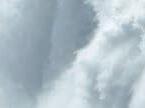

www.mazopublishers.com
148 pages - ISBN 978-1946124-883






“People Love Dead Jews: Reports from a Haunted Present”
Agroup of adventurers arrived at Morgur’s Mound, an archaeological site ringed with dragon bones. They found a treasure, scooped it up and made a run for it — but suddenly the ground began to shake.
“Four animated thunder beast skeletons erupt from the mound and attack you,” the dungeon master said. “You desecrated a holy site, and these are the guardians of the holy site. Everybody roll initiative.”
“Are you allowed to roll on Shabbos?” a player wondered, breaking the fourth wall of the game.
“You’re allowed to roll on Shabbos,” another answered, “but you’re not allowed to pick up a pencil and write down your hit points.”
So began a recent session of classic fantasy role-playing game Dungeons & Dragons.
This group of eight D&D players are all rabbis. They live in Nevada, Ohio, New York and one lives in Arizona: Temple Beth Sholom of the East Valley Rabbi Herschel ‘Brodie’ Aberson.
They’ve formed a friendship that has transcended denominational lines, providing general support during the isolating pandemic and a sounding board for the challenges they face serving their communities.
“The ability to play D&D, not just with rabbis, but with friends from all over the place, has been a key part of
maintaining my own sanity, especially during this pandemic,”Aberson told Jewish News.
The rabbi’s D&D group formed in August 2020, and Aberson learned about it through a live-actionrole-playing-game friend, who is also a rabbi.
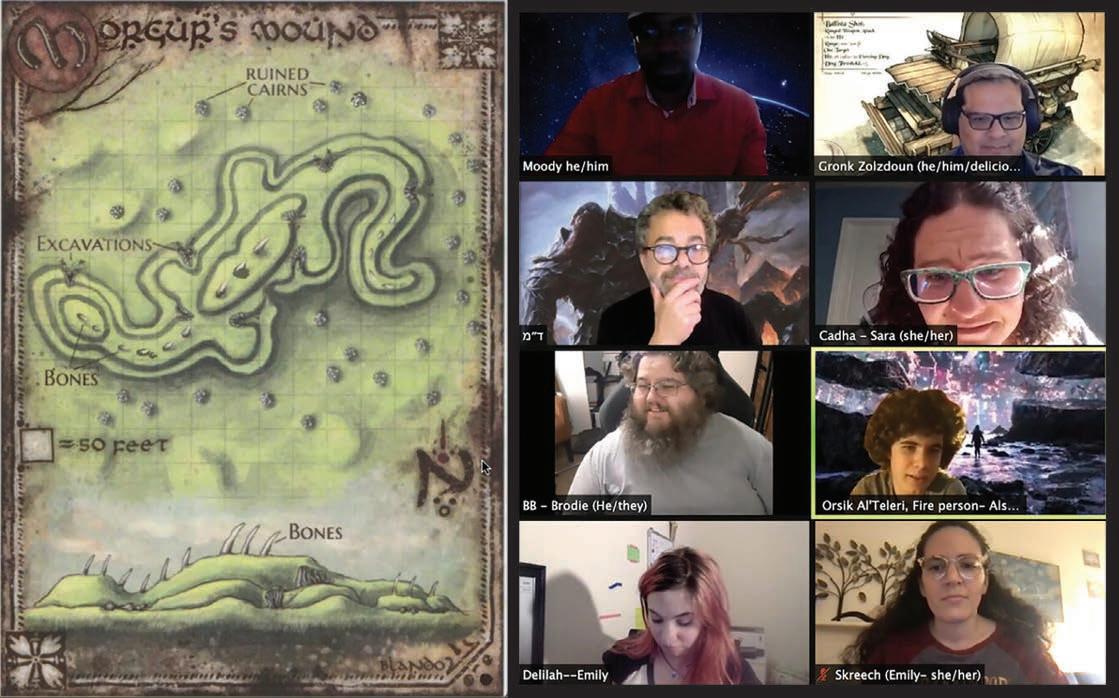
The eight rabbis in the group represent
to join the D&D group.
“Rabbis are nerds,” Uriarte said when asked why a group of rabbis would want to play D&D together. “You kind of have to be if you want to do this job, so there is a lot of overlap with sci-fi, fantasy and gaming.”
She said she eagerly anticipates the game sessions, when she can shed her public persona and lose herself for a few hours in her character, a dwarven barbarian named Cadha Stoneshield.
“We all look for places where we’re not the rabbi, or where we’re not ‘Rabbi’ as our first name, and finding those spaces has been even harder since the pandemic because many of us are isolated,” Zober said. “This lets me be the ragey, shootem-up action figure that I wish I could be sometimes.” She added that she appreciates the relaxed atmosphere, where “if I drop an F-bomb, we’re not going to have a board meeting about it.”
Rabbi Emily Cohen, spiritual leader of the West End Synagogue in Manhattan, said her half-rogue character, Skreech, “has a little bit of me in it, being off the beaten track slightly from what people might expect.” She is a Reconstructionist rabbi and a self-identified queer millennial.
Aberson said the way the group engages with each other shows that denominational divides are more human-made than structural.
Most have never met each other in person, and the group was starting to talk about an in-person get together before the delta variant emerged as a threat.
“We were almost to the point where we were like, ‘OK, there’s a little hope at the end of the tunnel; then we had pandemic 2.0 happen,” Aberson said.
After the High Holidays ended, he introduced a D&D game to some students in the TBSEV religious school.
“Temple Beth Sholom is back to in-person on Sundays, and I haven’t had a week where a kid in the older class hasn’t come up to me and said, ‘Hey Rabbi, when are we going to do the D&D thing?’”
He said it’s a chance to have fun with the kids, and it’s a chance for kids to be social together.
a cross-section of American Judaism, representing the major denominations, from Reconstructionist to Orthodox.
To Rabbi Shais Rishon, a prominent Black Orthodox rabbi and writer in New City, New York, the group represents a place where everyone can be their unfiltered, imperfect selves.
“This is a space where it‘s like, hey, there are things that we don’t know, and it’s OK to say that in this space without it being seen as a knock on our scholarship, or our knowledge base, or our authenticity,” he said.
Reform Rabbi Erik Uriarte, of Temple Israel in Lawrence, New York, said board game meetups had been “a big social outlet” for him, so when COVID closed off the opportunity to attend them, he was excited
Emily Dana, a third-year rabbinical student at Hebrew Union College-Jewish Institute of Religion in Cincinnati, said the group has shown her “it is possible to have people from incredibly different backgrounds be able to converse and debate in a friendly way with each other.”
Reform Rabbi Jonathan Freirich, the group’s dungeon master said the eight make “a supportive group of friends and colleagues.” His 13-year-old son, Jude, is also a member of the group.
For Rabbi Sara Zober, who is also Reform, playing D&D with her fellow rabbis has given her something to look forward to during the pandemic. In addition to leading Temple Sinai in Reno, Nevada, with her rabbi husband, Zober has four young children.
“Role playing games are a really great way to help people get outside themselves and interact socially with other people,” Aberson said. They create an opportunity for people to take social risks that they would not be comfortable doing otherwise.
For now, the rabbis say they will continue to play on Zoom as their schedules permit. There is a waiting list of those who want to join their sessions, Freirich said, but “the group is as big as it can get right now.”
Back at Morgur’s Mound, the adventurers fought off the thunder beast skeletons with surprising efficiency with the help of some lucky dice rolls.
“So you have your relic, and you survived the thunder beasts’ assault,” the dungeon master told the group. “What are you guys going to do now?” JN
“ROLE PLAYING GAMES ARE A REALLY GREAT WAY TO HELP PEOPLE GET OUTSIDE THEMSELVES AND INTERACT SOCIALLY WITH OTHER PEOPLE.”
Annual Peanut Butter & Fluff: 3-5 p.m. Join Temple Chai for an annual event dedicated to making peanut butter and fluff sandwiches to be donated to St. Vincent de Paul’s downtown kitchen. The event will be indoors; masks and social distancing are required. Temple Chai is located at 4645 E Marilyn Rd, Phoenix. For questions, contact Kaylie Medansky at kmedansky@templechai.com.

SUNDAY, JAN. 23
Special needs cooking class: Roberta’s Creations is offering two cooking classes for kids with special needs; one class is for kids 5-11 and another is for kids 12-18. Location: Beth El Congregation, 1118 W Glendale Ave, Phoenix. Cost: $45. For more information and to register, visit robertascreations.godaddysites.com/ special-needs-cooking.
THURSDAY, FEB. 3
Breakfast for Israel: 7:30-9 a.m. Join the JNFUSA Desert States Breakfast for Israel at JW Marriott Phoenix at Desert Ridge Resort. The annual event brings together the community to hear how your support continues to ensure a bright, prosperous future for the land and people of Israel. For more information and to register, visit jnf.org/events-landing-pages/ jewish-national-fund-breakfast-for-israel-desertstates-2021.
MONDAY, FEB. 7
Annual Card Party. 10 a.m. The Sun Lakes Jewish Congregation Sisterhood will meet at the Cottonwood Ballroom in Sun Lakes, located at 25630 S. Brentwood Dr., Sun Lakes, for a fundraiser benefiting local charities and organizations. Gather your friends who play bridge, canasta, Scrabble, RummiCube, pinochle or any other game and come to the event to enjoy a delicious catered lunch, raffles, huge gift baskets, and treats from a bake sale. For reservations or questions call Geri at 480-305-0123.
MONDAY, FEB. 28
Holocaust Educator Conference: 4:30-9 pm. Sponsored by the Bureau of Jewish Education in cooperation with Phoenix Holocaust Association and Arizona State University, teachers are invited to participate in this free conference. Keynote speakers will be Rachael Cerrotti, author and award-winning podcast host, and Grant Gochin, author, diplomat and chair of the Maceva Project in Lithuania. The conference will be at ASU, at 411 North Central Avenue, Phoenix. For more information, visit phxha.com/events/the2022-holocaust-educator-conference/ or email jewished@bjephoenix.org.
WEDNESDAYS
Generations After Descendants Forum: 11 a.m.-12:30 p.m. Join The East Valley Jewish Community Center’s Center for Holocaust Education, in partnership with the Phoenix Holocaust Association, for this in-person weekly discussion for children, grandchildren and descendants of Holocaust survivors, as well as those interested in learning more about the impact of the Holocaust. The meetings will be held outside. The program is designed for those who have received their COVID-19 vaccination and masks will be required. Coffee and tea provided. Reservations are mandatory. Cost: Free. Call 480-897-0588 to make your reservation or visit evjcc.org/generations-after. Contact Barbara
Bloom at 928-380-2360 with further questions. The EVJCC is located at 908 N Alma School Rd, Chandler.
THURSDAYS
Storytime at Modern Milk: 9:30 a.m. Bring your babies, toddlers and preschoolers to our weekly all ages in-person storytime at Modern Milk, 3802 N Scottsdale Rd Suite 163. We will integrate favorite children’s books and songs while giving parents new ideas for play. Cost: $5. For more information and to register, visit modernmilk. com/after-baby.
SUNDAYS
Bagels: 9-11 a.m. Join the Martin Pear JCC, 12701 N. Scottsdale Rd., Scottsdale, for Bagels And Gabbing every last Sunday of the month in-person. Grab a bagel and a cup of coffee and enjoy some time with your friends and make new ones. You must register to attend. Bagels and coffee will be provided. Cost: Free for members, $5 for guests. For more information and to register, visit apm.activecommunities.com/ valleyofthesunjcc/Activity_Search/1787.
MONDAYS
Mahjong: 10 a.m.-12:30 p.m. Join the East Valley Jewish Community Center in-person on Mondays for mahjong. This program is intended for players with prior experience and for those who have received the COVID-19 vaccination. Masks will be required. Cost: Free. For more information and to register, visit evjcc.org/mahjong. For further questions, call the EVJCC at 480-897-0588.
The EVJCC is located at 908 N Alma School Rd, Chandler.
SUNDAY, JAN. 16
Fighting Anti-Semitism; A Journalist’s Lessons: 7 p.m. In this Bureau of Jewish Education class, join Los Angeles-based journalist Annabelle Azade about the recent anti-Jewish acts of murder of Ilan Halimi, Mirelle Knoll, Sarah Halimi in France and the disturbing Anti-Semitic acts of violence in the United States. This talk will be live in person at Temple Solel, 6805 E McDonald Dr, Paradise Valley, as well as streamed online. Cost: $20. For more information and to register, visit bjephoenix.org/programs/passages.
MONDAY, DEC. 20
Medical Assistance: 1-2 p.m. In this virtual Valley Beit Midrash class, Rav Yoni Rosensweig will discuss whether a person is obligated to seek medical assistance. When we don’t feel well, we usually go and see the doctor. But do we have to? Can I let my health slip? Is there an obligation to stay healthy? Come and learn the basic sources behind this question and the meaning behind this technical discussion. Cost: $18. For more information and to register, visit valleybeitmidrash.org/event.
SUNDAY, JAN. 16
Families in Crisis; the childcare challenge: 3-4:30 p.m. Join the Women’s Leadership Institute for a virtual panel about child care costs. The panel will consist of an administrator, provider, parent and advocate and will address some of the major issues women in our community are facing. For more information and to register, visit womenlearning.org/events.
THURSDAY, JAN. 20
Gender fluidity and the Torah: 1-2 p.m. How does Jewish law, a system based on such binaries as muttar (permitted) and assur (prohibited) and hayav (obligated) and patur (exempt), inform our contemporary understanding of gender which is increasingly shaped by fluidity and in some cases hybridity? Would a trans woman who has not had gender confirmation surgery be required to undergo a ritual circumcision as part of her conversion process? Does the mitzvah of brit milah apply only to those whose gender is male or to all those whose anatomy is male? What are the consequences – halakhic, theological and cultural – of the different perspectives on this question? Discuss these questions in a virtual Valley Beit Midrash class with Rabbi Adina Lewittes. Cost: $18. For more information and to register, visit valleybeitmidrash.org/event.
SUNDAY, JAN. 30
Ultra Orthodox & Arab Integration in Israeli Society: 2 p.m. In this virtual Bureau of Jewish Education class, join Gill Hoffman to learn about the Ultra-Orthodox and Israeli-Arab integration in Israeli society. Hoffman has been the chief political correspondent and analyst for The Jerusalem Post for 20 years. He also teaches international communications at Israel’s College of Management and hosts a weekly radio show on the Land of Israel Network. The presentation will be over Zoom. Cost: $20. For more information and to register, visit bjephoenix.org/programs/ passages.
Tot Shabbat in the Park: 9:30 a.m. Free totshabbat every Friday morning at Cactus Park. Shabbat music, toys and a meaningful preschool shabbat experience. Is it your child’s birthday? Sponsor a shabbat for $36.00. For more information and to register, visit playdatesbydesign.com/upcoming-classes.
In-person services: Congregation Beth Israel is holding services in the Goldsmith Sanctuary limited to 100 people, excluding clergy and staff. Members and guests must be fully vaccinated (two weeks since your last vaccination) and wear mask. Children may attend and must be able to wear a mask for the duration of the service .Participants must pre-register by Thursday at 5 p.m. Priority will be given to members first and then guests. If there are more requests than available seats a lottery system will be used. To make your reservation, contact Gail Gilmartin at 480-951-0323 or at ggilmartin@cbiaz.org.
In-person services: Congregation Or Tzion is holding in-person Friday evening and Saturday morning Shabbat services indoors. Attendees must pre-register and attendance will be capped at 25. Participants will also have to bring a completed questionnaire with them and everybody’s temperature will be checked as they enter the synagogue. Masks will be required and seating is also socially distanced.
In-person services: Beth El Phoenix is offering in-person Shabbat services indoors, limited to 30 people, not including clergy. Masks and social distancing required as well as pre-registration via bethelphoenix.com/form/Shabbat-registration or by calling the office at (602) 944-3359.
Erev Shabbat Service: 5:30 p.m. Rabbi Alicia Magal will lead a service livstreamed for members of the Jewish Community of Sedona and the Verde Valley. Cost: Free. For more information and to obtain the Zoom link, visit jcsvv.org/contact.
Pre-Shabbat Kiddush Club: 6 p.m. Say kiddush with Rabbi Mendy levertov online. Cost: Free. Tune in here: ourjewishcenter. com/virtual. For more information, visit chabadaz.com. Shabbat at Beth El: 11-11:45 a.m. Celebrate Shabbat with songs, blessings and inspirational teachings. Rabbi Stein Kokin from Beth El Congregation will lead us the first Friday of every month. Special guests will be welcoming Shabbat during the remainder of the month. For more information or to join, visit bethelphoenix.com.
Welcome Shabbat: 11-11:45 a.m. Join the JFCS Virtual Center for Senior Enrichment each Friday for a soothing and inspiring program to welcome Shabbat. Each week a different guest host will lead the program with song and celebration. Cost: Free. For more information, visit jfcsaz.org/cse.
Kabbalat Shabbat: 5:30 p.m. Congregation Kehillah invites you to join services via Zoom, April 23, May 7 and 24, with Rabbi Bonnie Sharfman and cantorial soloists Scott Leader and Erica Erman. PowerPoint slides will be viewable if you don’t have “Gates of Prayer for Shabbat and Weekdays.” Services will be held April 23, May 7 and To register and receive the link, please email, info@congregationkehillah.org.
EVERY THIRD FRIDAY, JAN. 15-DEC. 31
Third Friday Shabbat: 7- 8 p.m. The Desert Foothills Jewish Community Association hosts a virtual abbreviated Shabbat service followed by a program. Contact Andrea at 480-664-8847 for more information.
SUNDAY, DEC. 19
Getting a Good Night’s Sleep: 11 a.m. Join Dr. Mark Gotfried for this virtual Wise Aging Speaker’s Bureau presentation. He is a recently retired board-certified physician in internal medicine, pulmonary disease and sleep disorders. Cost: $20. For more information and to register, visit bjephoenix.org/events/2021/ center-for-wise-aging-fall-speaker-seriesrabbi-steve-leder.
MONDAYS
Sip & Schmooze: 11 a.m. Sip on kosher coffee or tea, enjoy a homemade pastry and Schmooze with great company every second Monday of the month at Luci’s Barn at the Orchard, located at 7100 North 12th Street, Phoenix. RSVP Appreciated: chani@sosaz.org or (602) 492-7670. For more information, visit sosaz.org.
Tai Chi with Brian Stevens: 10-10:30 a.m. Tai Chi and Qigong are health practices that incorporate a form of ancient Korean healing martial arts known as DahnMuDo, which produces an overall limitless state of being, through focused movement and focused breathing. Experience a renewed sense of being, boost your immune system, and enjoy doing so in this virtual class. For more information and to register, visit jfcsaz.org/events/. Contact CSE Director Jennifer Brauner at seniorcenter@jfcsaz.org or 602-343-0192 with questions.
Brain Fitness: 1-2 p.m. Join Toby Lazarus in this virtual brain fitness class, which works to engage the brain in innovative ways in a variety of cognitive areas and can help increase mental acuity. Word play, puzzles, memory games and problem-solving activities are employed to enhance your brain power. Cost: Free. For more information and to register, visit jfcsaz.org/events/. Contact CSE Director Jennifer Brauner at seniorcenter@ jfcsaz.org or 602-343-0192 with questions.
Dance Fusion with Michele Dionisio: 11 a.m.noon. Presented by JFCS Center for Senior Enrichment. Cost: Free. For more information, visit jfcsaz.org/cse. JN
Temple Chai’s choir, led by Cantor Ross Wolman, entertains onlookers in Carefree on the eighth night of Chanukah.

Rep. Alma Hernandez addressed the crowd at the Capitol during Chanukah before lighting the shamash.
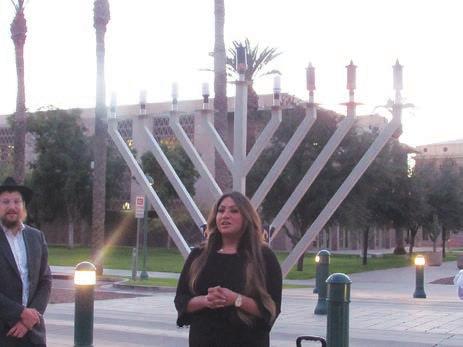
Jennifer Starrett, TribeNet co-founder, pauses for a photo at a happy hour event with Samara Schwartz Hurley. PHOTOS COURTESY OF JENNIFER STARRETT
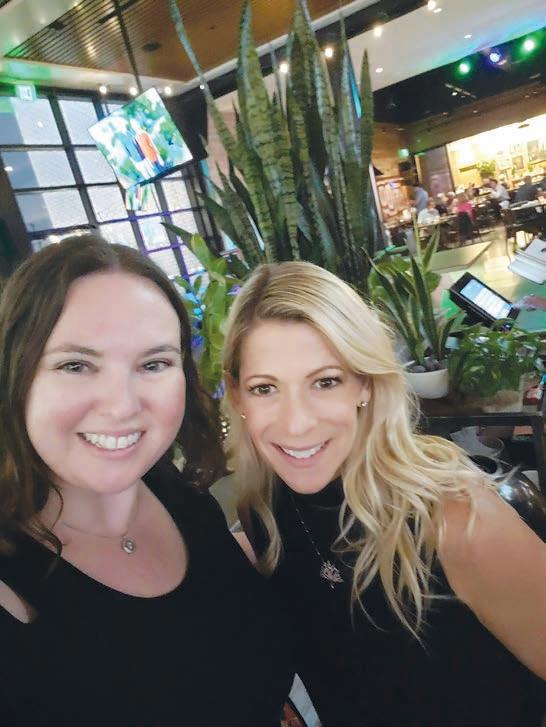
The Sun Lakes Jewish Congregation Men’s Club enjoyed its first in-person event of the 2021/2022 season: lunch at Portillo’s and a Fall League game at Sloan Park in Mesa.

OF ALAN BLOOM
Hillel at Arizona State University students and staff gather for its Latkepalooza Shabbat.

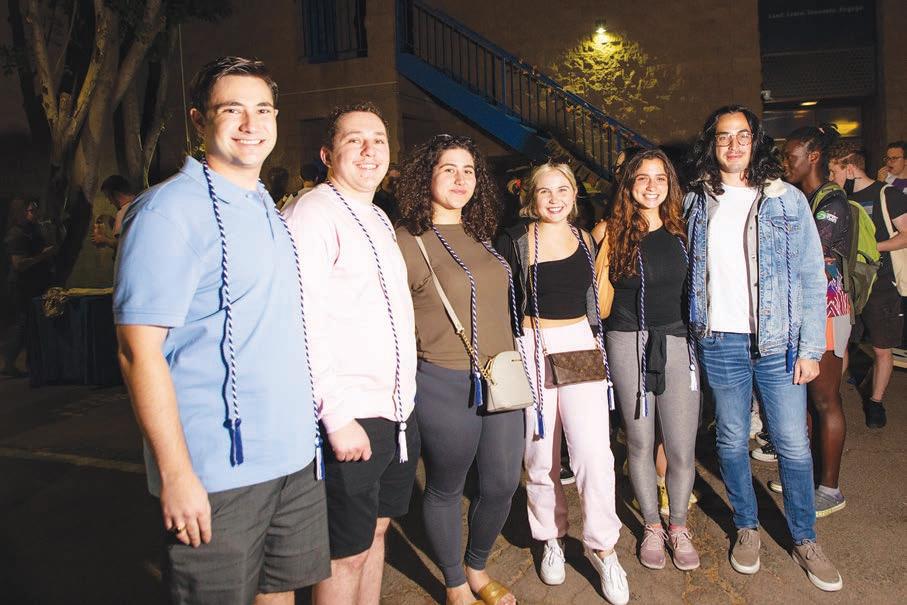
BY ANDREW GIBBS
Temple Solel high school youth leaders, in partnership with Shepherd of the Hills United Church of Christ, took the lead in organizing a festive event at Temple Solel on Dec. 5, to gather items for Afghan refugees. COURTESY RABBI JOHN LINDER
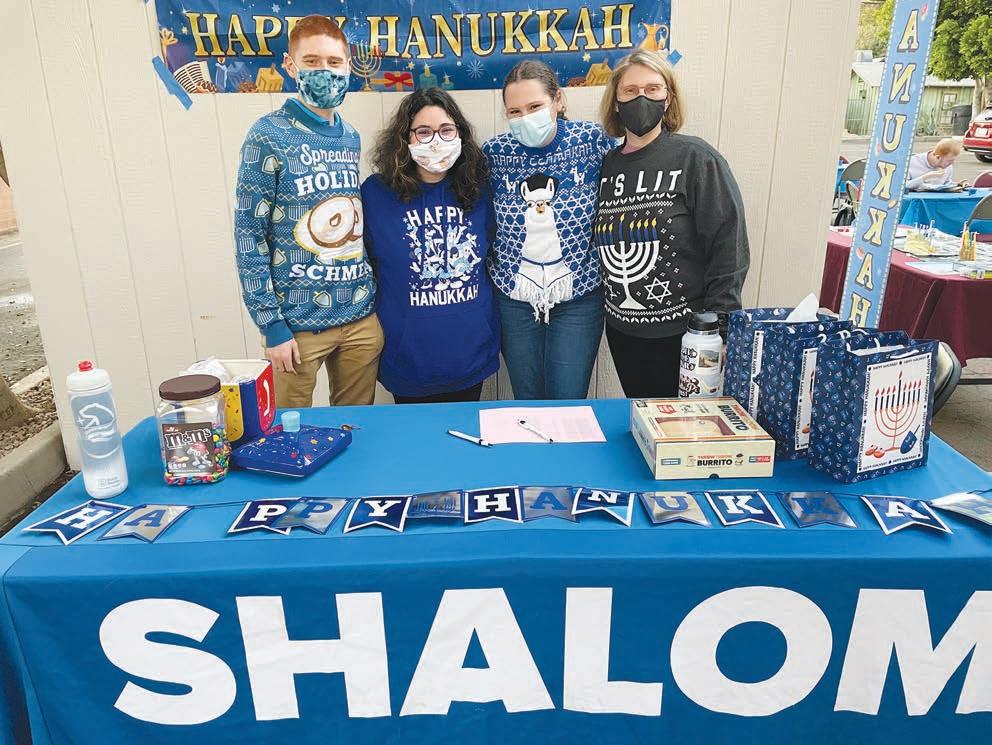
Beth Ami Temple honored Arnold Schwartz on his 90th birthday on Nov. 19. Arnie, a.k.a. “Mr. Beth Ami,” has been active in the temple in several capacities for over three decades. Rabbi Allison Lawton presented the congregation with a new Torah cover inscribed to honor his birthday and service to the congregation. Pictured from left: Rabbi Allison Lawton; Arnie Schwartz; Arnie's partner, Dennise Rowland; and his daughter, Elizabeth Siegler.

COURTESY OF ARNOLD SCHWARTZ
Students enjoying Hillel at ASU’s annual Food Truck Fest on Nov. 3, in Tempe.
BY ABDULLAH ZIA
Chabad at ASU’s director, Rabbi Shmuel Tiechtel, aims to continue his current work, with a few additions.
Tiechtel plans to add more Jewish learning classes, a Birthright trip and continue hosting socials on Tuesday evenings, Shabbat dinners on Fridays and their Sinai Scholars classes, as well as offering tables on campus with free food and helping men with their tefillin.

“Our goal is to be a source of love, warmth, connection, Jewish knowledge
CHANUKAH
CONTINUED FROM PAGE 6
This year’s annual celebrations marked the eighth year for Levertov, 24th for Deitsch, 11th for Lipskier and 10th in Gilbert for Ash. They also hire security just in case, though noted none have ever had any antisemitic incident occur.
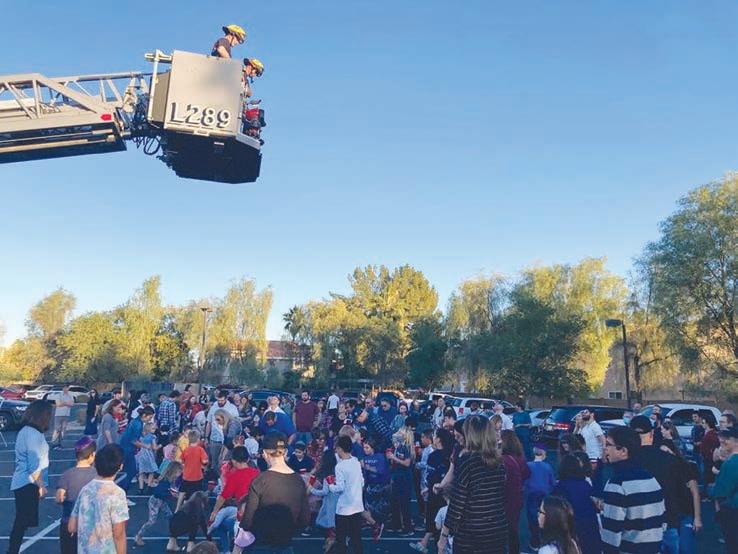
“We’ve only seen support,” Ash said. “There’s also non-Jews who come to these because they’re open for the public and people tell me all the time, ‘We’re here to support,’” he said. He, along with other event organizers, work with and invite town leaders and “they’re all very encouraging, and very much supportive of us having these events and working with us.”
Deitsh said it’s important to focus on the pride “every Jew has in celebrating their religion in an open, free, amazing country.”
He noted the support he felt from the state level, with traffic signs on the first
MILESTONES
and Jewish education for the students,” he said. “We want to continue being advocates for Jewish students, so they always know Chabad is a home for them for their Jewish needs. But also if you have a problem with a class, with a roommate, we will help you find resources within the university.”
Emily Singer, a senior studying landscape architecture and the student president of Chabad, stands fully behind Tiechtel’s vision.
“In the past year or so — I think because of COVID — we have lost a lot of our upperclassmen, and so we’re trying
night of Chanukah reading: “Slow down or you’ll spin like a dreidel.”
“It is especially warm and uplifting that despite what others claim is happening around the world, we are seeing positive messages and local Jewish pride being openly displayed,” Deitch said.
Doug Parcey, a spokesman for the Arizona Department of Transportation, said this is at least the second year that the agency has featured a Chanukah-related traffic safety message.
“We strive to create unconventional traffic safety messages that resonate and kickstart conversations about safe driving, both in-person and on social media, and result in drivers making better decisions behind the wheel,” Parcey said.
Lipskier said he is grateful to live in an inclusive town.
“We really needed this at this time. The Jewish community was so excited to be able to come out and celebrate together. It truly brought much needed light and hope into our hearts,” he said. JN
to reengage the juniors and seniors,” Singer said.
She wants to make sure that more women are involved, so she is planning on hosting women-only events such as art nights and game nights.
“Ultimately, it’s about meeting the students where they are,” Tiechtel said.
Matthew Friedman is a junior business management and entrepreneurship double major, serves on the Chabad board, and is the president of SunPAC, the AIPAC cadre on campus. He believes that word of mouth between students is the best way for the Jewish community
to become more involved.
“Finding Jewish people on campus and telling them about the events, especially hyping up the food and the community aspect, is the way to go,” he said. “Find people who don’t normally come to events and encourage them to come.”
Friedman believes that events from Olami, Hillel and Chabad are the best way for people to “stay in touch with their Judaism.” JN
Madeleine Steppel is a sophomore studying journalism and religious studies at Arizona State University.
Halle Lauren Gerst becomes a bat mitzvah on Jan. 8, 2022, at Temple Solel. She is the daughter of Mara and Matthew Gerst of Cave Creek. Grandparents are Ellyn and Jerry Lippman of Tucson; and Toby and Stephen Gerst of Phoenix.
For her mitzvah project, Halle is working with Arizona Helping Hands, the largest provider of essential needs for children in foster care in the state.

A student at Sonoran Trails Middle School, Halle enjoys dance, basketball
OBITUARY
DOREEN SAFERSTEIN
Doreen Saferstein, 84, died Dec. 3, 2021. She lived in Scottsdale. She is survived by her husband, Harold; her three sons; and two granddaughters. Arrangements by Sinai Mortuary. JN


January 17
From home health aides to financial planners, independent living facilities to nursing homes, this is the perfect venue to showcase how your business can help older Jewish residents navigate retirement.

January
40-CLASS SERIES: The 40 Greatest Debates in Jewish History!
Rabbi Dr. Shmuly Yanklowitz
Dec 21, ‘21 - Feb 22, ‘22 @ 10:00 am PT
Early Zionist Approaches to the Existing Arab Population Lauren Cohen Fisher

Monday, Jan 24 @ 1:00 pm MT
A Nation That Dwells Alone: Questions and Implications
Dr. Noam Weissman
Wednesday, Feb 9 @ 1:00 pm MT
The Seven Questions You’re Asked in Heaven
Rabbi Dr. Ron Wolfson

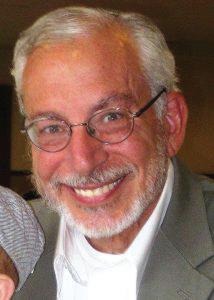


Thursday, Mar 3 @ 1:00 pm MT
White Supremacy and Antisemitism: Lessons from the Capital Attack
Professor Jonathan D. Sarna

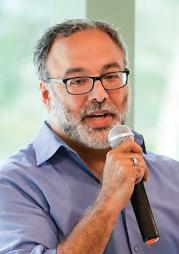

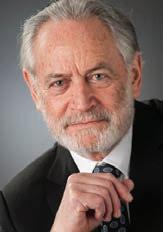
Monday, Apr 11 @ 1:00 pm PT
The Social Justice Torah Commentary –Book Talk
Rabbi Barry Block


Thursday, Jan 13 @ 1:00 pm MT
From Flood to Rainbow
Rabbi Avi Strausberg
Monday, Jan 31 @ 1:00 pm MT
Rabbinic Inferno: Hell in Classical Judaism
Rabbi Dr. Dov Weiss
Thursday, Feb 17 @ 1:00 pm MT
The Signi cance of the Mitzvot of Purim in our lives today
Rabbanit Sharona Halickman
Thursday, Mar 10 @ 9:00 am MT
To Be a Holy People, Jewish Tradition and Ethical Values
Rabbi Dr. Eugene Korn
Thursday, Apr 28 @ 10:00 am PT
Hiddur Mitzva: A Journey Through Jewish Ritual Art
Rabbi Chaim Seidler Feller
Wednesday, Jan 19 @ 1:00 pm MT
Peace-Building Insights After Eight Years of Meeting
Palestinians
Rabbi Hanan Schlesinger
Wednesday, Feb 2 @ 10:00 am MT
Zionism according to a New York Sheri & a Serbian Kabbalist
Jonnie Schnytzer


Tuesday, Feb 22 @ 1:00 pm MT
A Virtual Tour of the First Jewish Community in North America!
Janet R. Kirchheimer



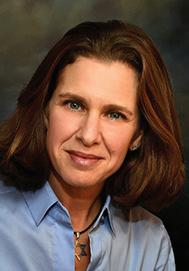
Thursday, Mar 24 @ 1:00 pm PDT
Messianism, Zionism, and Religious Radicalism: Four Spiritualties in Israel
Rabbi Menachem Creditor
Thursday, May 12 @ 1:00 pm PT
Requiring Brit Mikvah for female trans converts?
Rabbi Adina Lewittes
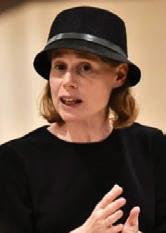

Thursday, Jan 20 @ 1:00 pm MT
How to Answer a Fool Professor Christine Hayes
Thursday, Feb 3 @ 1:00 pm MT
Maimonides, Spinoza and Us: Toward an Intellectually Vibrant Judaism
Rabbi Dr. Marc D. Angel


Thursday, Feb 24 @ 1:00 pm MT
Su ering Servants! How to Deal with the Missionary at the Door
Rabba Dr. Lindsey Taylor-Guthartz
Thursday, Apr 7 @ 11:00 am PT
King David: Man of War and Politics, Man of God, Man of Contradictions. Based on a close reading of the Books of Samuel Jeremy Rosen
Thursday, May 26 @ 1:00 pm PT
Ruach Hamidbar
Almost all events on Zoom, just $18 per event!
Season Pass Holders enjoy unlimited attendance for $54 a month Learn More at www.ValleyBeitMidrash.org

